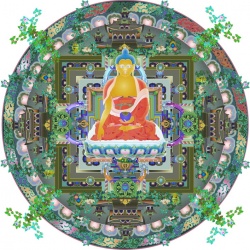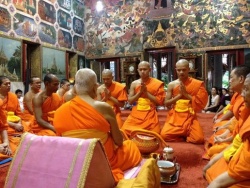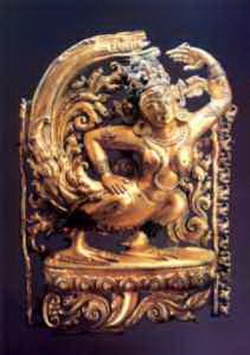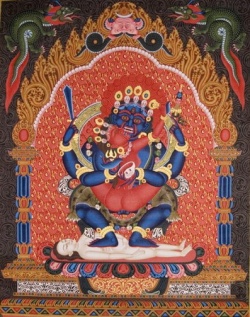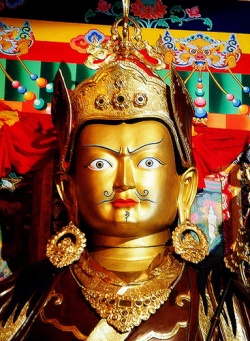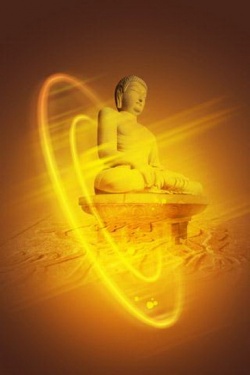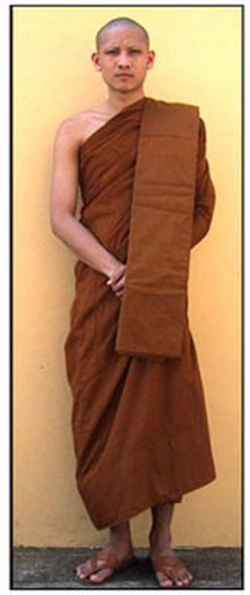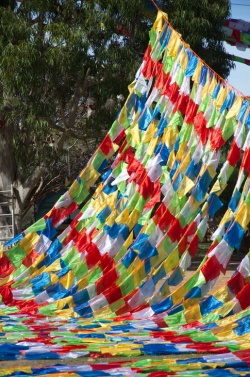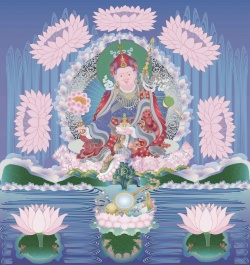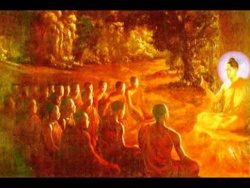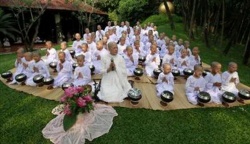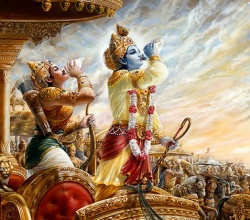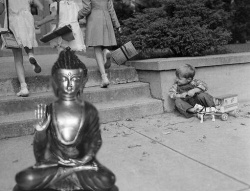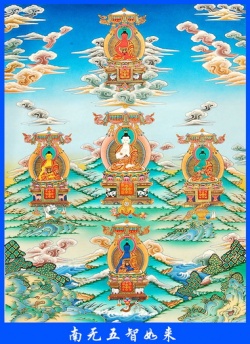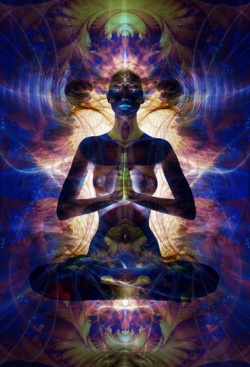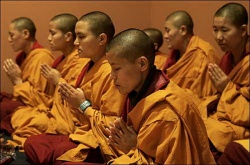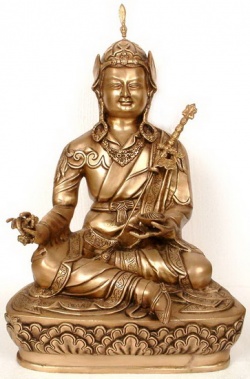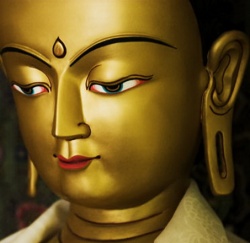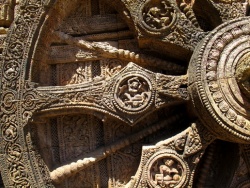Difference between revisions of "The Very Essence of Mind, Mahamudra, the One Sufficient Path by Gampopa"
| Line 17: | Line 17: | ||
[[Mahamudra]] has no [[causes]]. | [[Mahamudra]] has no [[causes]]. | ||
[[Mahamudra]] has no [[conditions]]. | [[Mahamudra]] has no [[conditions]]. | ||
| − | [[Mahamudra]] has no methods. | + | [[Mahamudra]] has no [[methods]]. |
[[Mahamudra]] has no [[path]]. | [[Mahamudra]] has no [[path]]. | ||
[[Mahamudra]] has no result. | [[Mahamudra]] has no result. | ||
| Line 26: | Line 26: | ||
"[[Mahamudra]] has no [[causes]]," and yet [[faith]] and [[devotion]] are the [[causes]] of [[mahamudra]]. | "[[Mahamudra]] has no [[causes]]," and yet [[faith]] and [[devotion]] are the [[causes]] of [[mahamudra]]. | ||
"[[Mahamudra]] has no [[conditions]]," and yet genuine [[gurus]] are the [[conditions]] for [[mahamudra]]. | "[[Mahamudra]] has no [[conditions]]," and yet genuine [[gurus]] are the [[conditions]] for [[mahamudra]]. | ||
| − | "[[Mahamudra]] has no methods," and yet uncontrived [[mind]] is the method of [[mahamudra]]. | + | "[[Mahamudra]] has no [[methods]]," and yet uncontrived [[mind]] is the method of [[mahamudra]]. |
"[[Mahamudra]] has no [[path]]," and yet undistracted [[mind]] is the [[path]] of [[mahamudra]]. | "[[Mahamudra]] has no [[path]]," and yet undistracted [[mind]] is the [[path]] of [[mahamudra]]. | ||
"[[Mahamudra]] has no result," and yet the [[mind]] {{Wiki|liberated}} into [[dharmata]] is the result of [[mahamudra]]. | "[[Mahamudra]] has no result," and yet the [[mind]] {{Wiki|liberated}} into [[dharmata]] is the result of [[mahamudra]]. | ||
| Line 34: | Line 34: | ||
As the [[preliminary practice]], [[meditate]] on [[guru yoga]] with [[faith]], [[devotion]], and [[respect]], three times during the day and three times at night.(i.e. preliminaries) | As the [[preliminary practice]], [[meditate]] on [[guru yoga]] with [[faith]], [[devotion]], and [[respect]], three times during the day and three times at night.(i.e. preliminaries) | ||
| − | As the main practice, rest within the state of uncontrived [[mind]] with undistracted recognition.(i.e. [[Samatha]]) | + | As the main practice, rest within the [[state]] of uncontrived [[mind]] with undistracted recognition.(i.e. [[Samatha]]) |
| − | As the conclusion, [[recognize]] whatever appears as your own [[mind]] and train your [[awareness]] with skill.(i.e. [[Insight]]) | + | As the conclusion, [[recognize]] whatever appears as your [[own]] [[mind]] and train your [[awareness]] with skill.(i.e. [[Insight]]) |
Relying upon the sequential [[arising]] of [[experiences]], exert yourself in [[meditation]] until [[conceptual mind]] is exhausted. | Relying upon the sequential [[arising]] of [[experiences]], exert yourself in [[meditation]] until [[conceptual mind]] is exhausted. | ||
| Line 58: | Line 58: | ||
This completes The Very [[Essence of Mind]], [[Mahamudra]], the One Sufficient [[Path]]. | This completes The Very [[Essence of Mind]], [[Mahamudra]], the One Sufficient [[Path]]. | ||
| − | Translated into English orally and later revised by Elizabeth Callahan. | + | Translated into English orally and later revised by [[Elizabeth]] Callahan. |
[[Tenga Rinpoche’s]] Commentary on The [[Mahamudra]] of the [[Venerable]] [[Gampopa]], the One Sufficient [[Path]] | [[Tenga Rinpoche’s]] Commentary on The [[Mahamudra]] of the [[Venerable]] [[Gampopa]], the One Sufficient [[Path]] | ||
| − | The following is an edited transcript of a commentary given by the Very [[Venerable]] [[Tenga Rinpoche]] at the [[Kalachakra]] for [[World]] [[Peace]] program at Madison Square Garden in 1991, translated by Elizabeth Callahan. | + | The following is an edited transcript of a commentary given by the Very [[Venerable]] [[Tenga Rinpoche]] at the [[Kalachakra]] for [[World]] [[Peace]] program at [[Madison]] [[Square]] [[Garden]] in 1991, translated by [[Elizabeth]] Callahan. |
| − | I would like to extend my welcome to all of you who have [[gathered]] here today. My [[greetings]] to all the [[gurus]], [[scholars]], [[teachers]], and [[dharma]] practitioners who have come because of a shared connection with the [[dharma]]. | + | I would like to extend my welcome to all of you who have [[gathered]] here today. My [[greetings]] to all the [[gurus]], [[scholars]], [[teachers]], and [[dharma]] practitioners who have come because of a shared [[connection]] with the [[dharma]]. |
We are extremely [[fortunate]] to have [[gathered]] here at this very special [[time]], which is unlike any other [[time]]. We are very [[fortunate]] because [[His Holiness the Dalai Lama]], the [[master]] of all the [[traditions]] of the [[Buddha’s teachings]] found in [[Tibet]], is here. [[His Holiness]] is considered to be an [[emanation]] of [[Chenrezig]] [[[Sanskrit]]: [[Avalokiteshvara]]), the [[Bodhisattva of Compassion]], emanated in [[human]] [[form]] as a [[vajra master]] residing on a very high level of [[spiritual]] [[attainment]]. [[Chenrezig]] is the [[embodiment]] of the [[compassion]] of all [[buddhas]] and [[bodhisattvas]]. Thus, [[His Holiness the Dalai Lama]] is the actual [[embodiment]] of [[compassion]], and as such works for the [[benefit]] of all [[beings]] throughout this [[world]] to pacify their [[sufferings]], both on a {{Wiki|temporal}} level and on an [[Wikipedia:Absolute (philosophy)|ultimate]] level. Through his [[great compassion]] he is [[able]] to bring this about. In particular, [[His Holiness]] is the leader of the [[people]] of [[Tibet]] and is [[able]] through his [[great compassion]] to bring [[benefit]] to them on both a {{Wiki|temporal}} and an [[Wikipedia:Absolute (philosophy)|ultimate]] level. | We are extremely [[fortunate]] to have [[gathered]] here at this very special [[time]], which is unlike any other [[time]]. We are very [[fortunate]] because [[His Holiness the Dalai Lama]], the [[master]] of all the [[traditions]] of the [[Buddha’s teachings]] found in [[Tibet]], is here. [[His Holiness]] is considered to be an [[emanation]] of [[Chenrezig]] [[[Sanskrit]]: [[Avalokiteshvara]]), the [[Bodhisattva of Compassion]], emanated in [[human]] [[form]] as a [[vajra master]] residing on a very high level of [[spiritual]] [[attainment]]. [[Chenrezig]] is the [[embodiment]] of the [[compassion]] of all [[buddhas]] and [[bodhisattvas]]. Thus, [[His Holiness the Dalai Lama]] is the actual [[embodiment]] of [[compassion]], and as such works for the [[benefit]] of all [[beings]] throughout this [[world]] to pacify their [[sufferings]], both on a {{Wiki|temporal}} level and on an [[Wikipedia:Absolute (philosophy)|ultimate]] level. Through his [[great compassion]] he is [[able]] to bring this about. In particular, [[His Holiness]] is the leader of the [[people]] of [[Tibet]] and is [[able]] through his [[great compassion]] to bring [[benefit]] to them on both a {{Wiki|temporal}} and an [[Wikipedia:Absolute (philosophy)|ultimate]] level. | ||
| − | So, even in a very specific [[sense]], he is [[able]] to be of great [[benefit]] to [[beings]]. In these next few days [[His Holiness]] will continue in his [[effort]] to bring [[peace]] and [[benefit]] to all [[beings]] in the [[world]] by bestowing the [[empowerment]] of [[Kalachakra]] - by [[manifesting]] the [[form]], [{{Wiki|speech}}, and [[mind]]) of [[Kalachakra]] in order to grant us this [[empowerment]]. We are very [[fortunate]] to have this opportunity to receive such an [[empowerment]]. The [[empowerment]] and the teachings of the [[Kalachakra Tantra]] were first requested of the [[Buddha Shakyamuni]] by the [[dharma king]] [[Dawa Zangpo]] at the place called the [[Drepung]] [[Stupa]]. In response, the [[Buddha Shakyamuni]] bestowed both the [[tantra]] and the oral instructions of [[Kalachakra]]. In general there are said to be four classes or divisions of [[tantra]], of which the fourth is called [[anuttara tantra]]. [[Anuttara tantras]] are divided into [[father tantras]] and [[mother tantras]]. The [[Kalachakra Tantra]] is considered to be a [[mother tantra]], and within these [[mother tantras]] the [[Kalachakra Tantra]] is considered to be like the {{Wiki|monarch}}. It is also considered to be the pinnacle of all the vehicles or [[yanas]]. Thus, there are no higher or greater [[empowerments]] or special instructions than those connected with the [[Kalachakra Tantra]]. For that [[reason]] it is said to be like the {{Wiki|monarch}} of all [[tantras]]. | + | So, even in a very specific [[sense]], he is [[able]] to be of great [[benefit]] to [[beings]]. In these next few days [[His Holiness]] will continue in his [[effort]] to bring [[peace]] and [[benefit]] to all [[beings]] in the [[world]] by bestowing the [[empowerment]] of [[Kalachakra]] - by [[manifesting]] the [[form]], [{{Wiki|speech}}, and [[mind]]) of [[Kalachakra]] in order to grant us this [[empowerment]]. We are very [[fortunate]] to have this opportunity to receive such an [[empowerment]]. The [[empowerment]] and the teachings of the [[Kalachakra Tantra]] were first requested of the [[Buddha Shakyamuni]] by the [[dharma king]] [[Dawa Zangpo]] at the place called the [[Drepung]] [[Stupa]]. In response, the [[Buddha Shakyamuni]] bestowed both the [[tantra]] and the [[oral instructions]] of [[Kalachakra]]. In general there are said to be four classes or divisions of [[tantra]], of which [[the fourth]] is called [[anuttara tantra]]. [[Anuttara tantras]] are divided into [[father tantras]] and [[mother tantras]]. The [[Kalachakra Tantra]] is considered to be a [[mother tantra]], and within these [[mother tantras]] the [[Kalachakra Tantra]] is considered to be like the {{Wiki|monarch}}. It is also considered to be the pinnacle of all the vehicles or [[yanas]]. Thus, there are no higher or greater [[empowerments]] or special instructions than those connected with the [[Kalachakra Tantra]]. For that [[reason]] it is said to be like the {{Wiki|monarch}} of all [[tantras]]. |
For these [[reasons]] we are extremely [[fortunate]] to be [[able]] at this [[time]] to receive from such a great [[vajra master]] such an [[empowerment]] with these teachings, which are like the {{Wiki|monarch}} or pinnacle of all teachings. So, from my [[heart]], I would like to extend my thanks to all the patrons who have made this event possible and to all those who have helped bring this event about in any way. | For these [[reasons]] we are extremely [[fortunate]] to be [[able]] at this [[time]] to receive from such a great [[vajra master]] such an [[empowerment]] with these teachings, which are like the {{Wiki|monarch}} or pinnacle of all teachings. So, from my [[heart]], I would like to extend my thanks to all the patrons who have made this event possible and to all those who have helped bring this event about in any way. | ||
| − | While I am explaining a bit about the teachings of [[mahamudra]], I request all of you to give rise to a very special [[attitude]] and [[aspiration]] while you are listening. You should think that it is in order to bring about the [[peace]] and [[happiness]] of all [[beings]] that you are now listening to these instructions on the [[path]] of [[mahamudra]]. And what type of [[aspiration]] or aspirational [[prayer]] should you make in this connection? You should wish that all the [[roots]] of [[virtue]] that are [[accumulated]] due to having received these instructions on [[mahamudra]] will bring about the [[peace]] and [[happiness]] of all [[beings]]. | + | While I am explaining a bit about the teachings of [[mahamudra]], I request all of you to give rise to a very special [[attitude]] and [[aspiration]] while you are listening. You should think that it is in order to bring about the [[peace]] and [[happiness]] of all [[beings]] that you are now listening to these instructions on the [[path]] of [[mahamudra]]. And what type of [[aspiration]] or aspirational [[prayer]] should you make in this [[connection]]? You should wish that all the [[roots]] of [[virtue]] that are [[accumulated]] due to having received these instructions on [[mahamudra]] will bring about the [[peace]] and [[happiness]] of all [[beings]]. |
| − | In general, [[peace]] and [[happiness]] depend upon one’s [[mind]]. Whether one attains [[happiness]] or does not attain [[happiness]] is entirely [[dependent upon]] one’s own [[mind]]. All [[beings]] have [[mental afflictions]] - the six [[poisons]], which are [[anger]], [[attachment]], [[ignorance]], [[pride]], [[greed]], and [[jealousy]]. Based upon [[thoughts]] that arise out of these {{Wiki|poisonous}} [[mental afflictions]], one performs [[actions]] with one’s [[body]], {{Wiki|speech}}, and [[mind]]. Based upon such [[actions]], one accumulates [[karma]], and if these [[actions]] harm other [[beings]], they are considered to be negative or [[nonvirtuous]] [[actions]] accumulating [[negative karma]]. Such [[negative actions]] give rise to [[suffering]] both temporarily and in the long term. | + | In general, [[peace]] and [[happiness]] depend upon one’s [[mind]]. Whether one attains [[happiness]] or does not attain [[happiness]] is entirely [[dependent upon]] one’s [[own]] [[mind]]. All [[beings]] have [[mental afflictions]] - the six [[poisons]], which are [[anger]], [[attachment]], [[ignorance]], [[pride]], [[greed]], and [[jealousy]]. Based upon [[thoughts]] that arise out of these {{Wiki|poisonous}} [[mental afflictions]], one performs [[actions]] with one’s [[body]], {{Wiki|speech}}, and [[mind]]. Based upon such [[actions]], one accumulates [[karma]], and if these [[actions]] harm other [[beings]], they are considered to be negative or [[nonvirtuous]] [[actions]] accumulating [[negative karma]]. Such [[negative actions]] give rise to [[suffering]] both temporarily and in the long term. |
As long as one has negative [[states of mind]] that give rise to [[negative actions]], one will not [[experience]] [[peace]], but will only [[experience]] [[suffering]]. The different types of [[suffering]] that we [[experience]] in this [[lifetime]] are called temporary [[suffering]]. The [[suffering]] which arises in {{Wiki|future}} [[lives]], such as being born in any one of the lower states - the [[hell realms]], the [[hungry ghost]] [[realms]], or the [[animal realms]] - is considered to be more longterm [[suffering]]. The [[cause]] of both of these types of [[suffering]] is the [[mental afflictions]]. Both types of [[suffering]] arise for oneself and for other [[beings]]. | As long as one has negative [[states of mind]] that give rise to [[negative actions]], one will not [[experience]] [[peace]], but will only [[experience]] [[suffering]]. The different types of [[suffering]] that we [[experience]] in this [[lifetime]] are called temporary [[suffering]]. The [[suffering]] which arises in {{Wiki|future}} [[lives]], such as being born in any one of the lower states - the [[hell realms]], the [[hungry ghost]] [[realms]], or the [[animal realms]] - is considered to be more longterm [[suffering]]. The [[cause]] of both of these types of [[suffering]] is the [[mental afflictions]]. Both types of [[suffering]] arise for oneself and for other [[beings]]. | ||
| Line 80: | Line 80: | ||
Instead, one should engage as much as one can in developing [[compassion]], [[loving kindness]], and [[diligence]], in being generous to all [[beings]], in maintaining [[discipline]], in practicing [[patience]] with other’s [[anger]], and so forth. One should engage in [[virtue]] and follow in [[virtuous]] ways as much as one can. By practicing [[virtue]], one will be of [[benefit]] to others. And if one acts in ways beneficial to others, one will also attain [[happiness]] for oneself in this [[lifetime]], in the next, and in all {{Wiki|future}} [[lives]], and eventually one will attain [[enlightenment]]. One will be [[able]] to bring about both the temporary and long-term [[happiness]] of others. This is what is called [[happiness]] and [[peace]]. | Instead, one should engage as much as one can in developing [[compassion]], [[loving kindness]], and [[diligence]], in being generous to all [[beings]], in maintaining [[discipline]], in practicing [[patience]] with other’s [[anger]], and so forth. One should engage in [[virtue]] and follow in [[virtuous]] ways as much as one can. By practicing [[virtue]], one will be of [[benefit]] to others. And if one acts in ways beneficial to others, one will also attain [[happiness]] for oneself in this [[lifetime]], in the next, and in all {{Wiki|future}} [[lives]], and eventually one will attain [[enlightenment]]. One will be [[able]] to bring about both the temporary and long-term [[happiness]] of others. This is what is called [[happiness]] and [[peace]]. | ||
| − | In addition to these types of methods* that need to be [[taught]], the [[Buddha Shakyamuni]] also [[taught]] many other methods for disciplining and {{Wiki|training}} one’s [[mind]]. These methods are included in such teachings as [[mahamudra]], [[dzogchen]], [[madhyamaka]], [[prajnaparamita]], and so forth. All of the profound teachings given by the [[Buddha]] were [[taught]] in order that one be [[able]] to [[discipline]] and train one’s own [[mind]]. There are many methods [[taught]] for the practice of [[mahamudra]] [[meditation]], but in brief, all of these methods can be included under two types: | + | In addition to these types of [[methods]]* that need to be [[taught]], the [[Buddha Shakyamuni]] also [[taught]] many other [[methods]] for [[disciplining]] and {{Wiki|training}} one’s [[mind]]. These [[methods]] are included in such teachings as [[mahamudra]], [[dzogchen]], [[madhyamaka]], [[prajnaparamita]], and so forth. All of the profound teachings given by the [[Buddha]] were [[taught]] in order that one be [[able]] to [[discipline]] and train one’s [[own]] [[mind]]. There are many [[methods]] [[taught]] for the practice of [[mahamudra]] [[meditation]], but in brief, all of these [[methods]] can be included under two types: |
those connected with the [[sutra path]],** | those connected with the [[sutra path]],** | ||
and those connected with the [[secret mantra]] or [[vajrayana]] [[path]].*** | and those connected with the [[secret mantra]] or [[vajrayana]] [[path]].*** | ||
| − | *Editor’s note: It may seem strange to consider giving up [[evil]] [[deeds]] and [[states of mind]] and [[cultivating]] [[virtuous]] [[deeds]] and [[states of mind]] as "methods" of [[mental]] {{Wiki|training}} that lead to [[happiness]]. That [[virtuous]] [[action]] leads to [[happiness]] and [[evil]] [[action]] leads to [[suffering]] seems so tautological that to consider [[teaching]] them as a "method" might seem simplistic. But if one considers the {{Wiki|world view}} of the [[Buddha Shakyamuni’s]] contemporaries in {{Wiki|Greece}}, for example - one of the cradles of our {{Wiki|Western civilization}} - one finds the notion that [[happiness]] arises through the force of arms, the strong destroying the weak, robbing them of their goods, pillaging their villages, raping their women, {{Wiki|killing}} their men, and enslaving their women and children. Indeed, if one turns on CNN, one is hard pressed not to think that that [[view]] still holds sway in many of the [[realms]] of this [[world]]. | + | *Editor’s note: It may seem strange to consider giving up [[evil]] [[deeds]] and [[states of mind]] and [[cultivating]] [[virtuous]] [[deeds]] and [[states of mind]] as "[[methods]]" of [[mental]] {{Wiki|training}} that lead to [[happiness]]. That [[virtuous]] [[action]] leads to [[happiness]] and [[evil]] [[action]] leads to [[suffering]] seems so tautological that to consider [[teaching]] them as a "method" might seem simplistic. But if one considers the {{Wiki|world view}} of the [[Buddha Shakyamuni’s]] contemporaries in {{Wiki|Greece}}, for example - one of the cradles of our {{Wiki|Western civilization}} - one finds the notion that [[happiness]] arises through the force of arms, the strong destroying the weak, robbing them of their goods, pillaging their villages, raping their women, {{Wiki|killing}} their men, and enslaving their women and children. Indeed, if one turns on CNN, one is hard pressed not to think that that [[view]] still holds sway in many of the [[realms]] of this [[world]]. |
**Editor’s note: The [[exoteric mahayana]] [[path]] | **Editor’s note: The [[exoteric mahayana]] [[path]] | ||
| Line 93: | Line 93: | ||
Referring to the teachings connected with the [[sutra]] [[tradition]], [[Nagarjuna]] wrote, "There is one [[path to liberation]] [[taught]] by the [[buddhas]], [[pratyekabuddhas]], and [[shravakas]]. It is definite that there are no others." "No other" means there is no other way to attain [[liberation]] than that one [[path]]. At the place in [[India]] called [[Vulture Peak]], the {{Wiki|perfect}} [[Buddha Shakyamuni]] - a [[supreme nirmanakaya]] - turned the [[wheel of the dharma]] a second [[time]], [[teaching]] the [[vehicle]] without [[characteristics]], and explained the meaning of [[emptiness]] in the extensive, middle length and concise presentations of the [[Prajnaparamita]]. This is something all of us should [[meditate]] upon using our [[intelligence]]. | Referring to the teachings connected with the [[sutra]] [[tradition]], [[Nagarjuna]] wrote, "There is one [[path to liberation]] [[taught]] by the [[buddhas]], [[pratyekabuddhas]], and [[shravakas]]. It is definite that there are no others." "No other" means there is no other way to attain [[liberation]] than that one [[path]]. At the place in [[India]] called [[Vulture Peak]], the {{Wiki|perfect}} [[Buddha Shakyamuni]] - a [[supreme nirmanakaya]] - turned the [[wheel of the dharma]] a second [[time]], [[teaching]] the [[vehicle]] without [[characteristics]], and explained the meaning of [[emptiness]] in the extensive, middle length and concise presentations of the [[Prajnaparamita]]. This is something all of us should [[meditate]] upon using our [[intelligence]]. | ||
| − | If one were to wonder, "Since the [[Buddha Shakyamuni]] [[taught]] this middle [[turning of the wheel of the dharma]], then is it not sufficient for us just to [[meditate]] upon these teachings under our own power or [[Wikipedia:Volition (psychology)|volition]], not relying upon another [[teacher]]?" No, it is not sufficient. [[Jowo]] [[Palden]] [[Atisha]] said, | + | If one were to [[wonder]], "Since the [[Buddha Shakyamuni]] [[taught]] this middle [[turning of the wheel of the dharma]], then is it not sufficient for us just to [[meditate]] upon these teachings under our [[own]] power or [[Wikipedia:Volition (psychology)|volition]], not relying upon another [[teacher]]?" No, it is not sufficient. [[Jowo]] [[Palden]] [[Atisha]] said, |
"If one asks, ‘Who realizes [[emptiness]],’ it is [[Nagarjuna]] and his [[student]] [[Chandrakirti]], who were prophesied by the [[Tathagata]] and who saw the [[truth]] of [[dharmata]].**** | "If one asks, ‘Who realizes [[emptiness]],’ it is [[Nagarjuna]] and his [[student]] [[Chandrakirti]], who were prophesied by the [[Tathagata]] and who saw the [[truth]] of [[dharmata]].**** | ||
| Line 102: | Line 102: | ||
****Editor’s note: the [[true nature of things]], the [[essence]] of [[reality]], the completely [[pure]] [[nature]], [[suchness]] | ****Editor’s note: the [[true nature of things]], the [[essence]] of [[reality]], the completely [[pure]] [[nature]], [[suchness]] | ||
| − | If one were to wonder, "How is this term, [[mahamudra]], explained in the [[sutras]]," there is a quote from the [[Samadhiraja Sutra]] which says, "The [[nature]] of all [[phenomena]] is [[mahamudra]]." This means that the [[nature]] of all [[phenomena]] is [[emptiness]]. [[Mahamudra]] in [[Tibetan]] is [[chakgya chenpo]]. [[Chak]] refers to [[emptiness]], and it means then that the [[nature]] of all [[phenomena]] is [[emptiness]]. [[Realizing]] the meaning of [[emptiness]], one is {{Wiki|liberated}} from [[samsara]], which is expressed by the [[word]] [[gya]]. This is how the term chakja [[chenpo]] or [[mahamudra]] is explained in the [[sutras]].* | + | If one were to [[wonder]], "How is this term, [[mahamudra]], explained in the [[sutras]]," there is a quote from the [[Samadhiraja Sutra]] which says, "The [[nature]] of all [[phenomena]] is [[mahamudra]]." This means that the [[nature]] of all [[phenomena]] is [[emptiness]]. [[Mahamudra]] in [[Tibetan]] is [[chakgya chenpo]]. [[Chak]] refers to [[emptiness]], and it means then that the [[nature]] of all [[phenomena]] is [[emptiness]]. [[Realizing]] the meaning of [[emptiness]], one is {{Wiki|liberated}} from [[samsara]], which is expressed by the [[word]] [[gya]]. This is how the term chakja [[chenpo]] or [[mahamudra]] is explained in the [[sutras]].* |
*Editor’s note: [[Chenpo]] means great, and, according to [[Kalu Rinpoche]], indicates that [[mahamudra]] is the [[Wikipedia:Absolute (philosophy)|ultimate]] [[experience]] and that there is nothing greater. | *Editor’s note: [[Chenpo]] means great, and, according to [[Kalu Rinpoche]], indicates that [[mahamudra]] is the [[Wikipedia:Absolute (philosophy)|ultimate]] [[experience]] and that there is nothing greater. | ||
| Line 112: | Line 112: | ||
**Editor’s note: The result of the [[attainment]] of [[enlightenment]] in the [[vajrayana]] is sometimes referred to as the [[vajra body]]. The use of this term is anticipated in the [[mahayana]] by the use of the term "the vajra-like [[samadhi]]," the [[indestructible]] [[samadhi]], which is the defining event in the [[attainment of buddhahood]]. | **Editor’s note: The result of the [[attainment]] of [[enlightenment]] in the [[vajrayana]] is sometimes referred to as the [[vajra body]]. The use of this term is anticipated in the [[mahayana]] by the use of the term "the vajra-like [[samadhi]]," the [[indestructible]] [[samadhi]], which is the defining event in the [[attainment of buddhahood]]. | ||
| − | To receive a complete [[empowerment]] in the [[secret mantra]] [[tradition]] from a genuine [[guru]] is something we all have the opportunity to do during the next few days, since [[His Holiness the Dalai Lama]] will be bestowing the [[Kalachakra empowerment]]. While one is receiving this [[empowerment]], one should think that the [[guru]] bestowing the [[empowerment]] is in [[actuality]] [[Kalachakra]], and that the place where the [[empowerment]] is being given is in [[actuality]] the palace of [[Kalachakra]]. One should think that the entire environment surrounding one, the whole [[world]], is the [[pure land]] of [[Kalachakra]]. And one should have the [[attitude]] that these ways of regarding the [[guru]], the structure or building, the environment, and the [[world]] are really the way they are in [[actuality]]. | + | To receive a complete [[empowerment]] in the [[secret mantra]] [[tradition]] from a genuine [[guru]] is something we all have the opportunity to do during the next few days, since [[His Holiness the Dalai Lama]] will be bestowing the [[Kalachakra empowerment]]. While one is receiving this [[empowerment]], one should think that the [[guru]] bestowing the [[empowerment]] is in [[actuality]] [[Kalachakra]], and that the place where the [[empowerment]] is being given is in [[actuality]] the palace of [[Kalachakra]]. One should think that the entire {{Wiki|environment}} surrounding one, the whole [[world]], is the [[pure land]] of [[Kalachakra]]. And one should have the [[attitude]] that these ways of regarding the [[guru]], the {{Wiki|structure}} or building, the {{Wiki|environment}}, and the [[world]] are really the way they are in [[actuality]]. |
When one is receiving an [[empowerment]], whatever {{Wiki|sounds}} one hears - all the words expressed in the [[empowerment]], all the instructions given - one should listen to and hear undistractedly. One should be focused one-pointedly on the meaning of these words. If one is not focused one-pointedly, if one becomes distracted while one is listening to the [[empowerment]] being given, although one will receive the [[blessings]] of the [[empowerment]], one will not be [[able]] to understand or receive the meaning of it. | When one is receiving an [[empowerment]], whatever {{Wiki|sounds}} one hears - all the words expressed in the [[empowerment]], all the instructions given - one should listen to and hear undistractedly. One should be focused one-pointedly on the meaning of these words. If one is not focused one-pointedly, if one becomes distracted while one is listening to the [[empowerment]] being given, although one will receive the [[blessings]] of the [[empowerment]], one will not be [[able]] to understand or receive the meaning of it. | ||
| − | Having received [[empowerment]] - for example, the [[Kalachakra empowerment]] - one then engages in the practice of the [[sadhana]] associated with it. One begins with the [[generation stage]], with the [[visualizations]] and the [[mantra]] recitations, and then one engages in the [[completion stage]] practices - which, in the case of [[Kalachakra]], would be "the six stages of union."*** If one practices [[meditation]] in this way, then one will be [[able]] to penetrate the [[vital]] points of the [[vajra body]]. | + | Having received [[empowerment]] - for example, the [[Kalachakra empowerment]] - one then engages in the practice of the [[sadhana]] associated with it. One begins with the [[generation stage]], with the [[visualizations]] and the [[mantra]] [[recitations]], and then one engages in the [[completion stage]] practices - which, in the case of [[Kalachakra]], would be "the six stages of union."*** If one practices [[meditation]] in this way, then one will be [[able]] to penetrate the [[vital]] points of the [[vajra body]]. |
| − | ***Editor’s note: Each system of [[tantric practice]] has its own particular [[generation and completion]] stage practices. In the [[Kagyu lineages]], the [[principal]] [[generation stage]] practices are [[Vajrayogini]] and [[Chakrasamvara]], and the [[completion stage]] practice is the [[Six Doctrines of Naropa]]. In the [[Shangpa Kagyu lineage]], the [[generation stage]] practice is [[Chakrasamvara]] and The [[Deities]] of the Five Classes of [[Tantra]], while the [[completion stage]] practice is the [[Six Doctrines of Niguma]]. In the [[Nyingma]] system, the [[completion stage]] practices are [[Trekchöd]] and [[Thögal]]. | + | ***Editor’s note: Each system of [[tantric practice]] has its [[own]] particular [[generation and completion]] stage practices. In the [[Kagyu lineages]], the [[principal]] [[generation stage]] practices are [[Vajrayogini]] and [[Chakrasamvara]], and the [[completion stage]] practice is the [[Six Doctrines of Naropa]]. In the [[Shangpa Kagyu lineage]], the [[generation stage]] practice is [[Chakrasamvara]] and The [[Deities]] of the Five Classes of [[Tantra]], while the [[completion stage]] practice is the [[Six Doctrines of Niguma]]. In the [[Nyingma]] system, the [[completion stage]] practices are [[Trekchöd]] and [[Thögal]]. |
Based upon penetrating the [[vital]] points of the [[vajra body]], the [[karmic]] [[prana]] or [[winds]] enter into, abide and dissolve within the [[avadhuti]] or [[central channel]]. Through the force of that, one’s [[karmic]] [[prana]] is [[purified]] and coemergent [[wisdom]], great [[bliss]], arises as what is called a [[mental]] image or a [[mental]] approximation of [[wisdom]],* which is known as the [[luminosity]] of example or the [[mahamudra]] of example. Through [[meditating]] repeatedly upon the [[luminosity]] of example-mahamudra one will be [[able]] to realize the actual [[luminosity]] or [[Wikipedia:Absolute (philosophy)|ultimate]] luminosity-mahamudra. | Based upon penetrating the [[vital]] points of the [[vajra body]], the [[karmic]] [[prana]] or [[winds]] enter into, abide and dissolve within the [[avadhuti]] or [[central channel]]. Through the force of that, one’s [[karmic]] [[prana]] is [[purified]] and coemergent [[wisdom]], great [[bliss]], arises as what is called a [[mental]] image or a [[mental]] approximation of [[wisdom]],* which is known as the [[luminosity]] of example or the [[mahamudra]] of example. Through [[meditating]] repeatedly upon the [[luminosity]] of example-mahamudra one will be [[able]] to realize the actual [[luminosity]] or [[Wikipedia:Absolute (philosophy)|ultimate]] luminosity-mahamudra. | ||
| − | *Editor’s note: The meaning of coemergent [[wisdom]] is succinctly explained by [[Chögyam]] Thrungpa in The [[Heart]] of the [[Buddha]] in connection with the [[sadhana]] of [[Vajrayogini]]: "Fundamentally, the [[magic]] of the [[vajrayana tradition]] is the ability to [[transform]] {{Wiki|confusion}} into [[wisdom]] on the spot. From the point of [[view]] of [[vajrayana]], real [[magic]], or [[siddhi]], in [[Sanskrit]], is the ability to work with and tame one’s [[mind]]. This is completely different from the usual notion of [[magic]] as a [[supernatural power]] over the [[universe]]. As mentioned in the previous [[discussion]] of the [[samayas]] of [[body]], {{Wiki|speech}}, and [[mind]], any potential {{Wiki|confusion}} and neurosis become an opportunity to [[experience]] [[sacred]] outlook. At the beginning of the [[path of meditation]], we work to tame our [[minds]] and subdue the forces of {{Wiki|confusion}}. In the [[mahayana]], we see the [[emptiness]] of [[self]] and [[phenomena]]; out of that, we rouse [[compassion]] for [[beings]] who do not realize the [[emptiness]], and therefore the freedom, of their [[nature]]. | + | *Editor’s note: The meaning of coemergent [[wisdom]] is succinctly explained by [[Chögyam]] Thrungpa in The [[Heart]] of the [[Buddha]] in [[connection]] with the [[sadhana]] of [[Vajrayogini]]: "Fundamentally, the [[magic]] of the [[vajrayana tradition]] is the ability to [[transform]] {{Wiki|confusion}} into [[wisdom]] on the spot. From the point of [[view]] of [[vajrayana]], real [[magic]], or [[siddhi]], in [[Sanskrit]], is the ability to work with and tame one’s [[mind]]. This is completely different from the usual notion of [[magic]] as a [[supernatural power]] over the [[universe]]. As mentioned in the previous [[discussion]] of the [[samayas]] of [[body]], {{Wiki|speech}}, and [[mind]], any potential {{Wiki|confusion}} and neurosis become an opportunity to [[experience]] [[sacred]] outlook. At the beginning of the [[path of meditation]], we work to tame our [[minds]] and subdue the forces of {{Wiki|confusion}}. In the [[mahayana]], we see the [[emptiness]] of [[self]] and [[phenomena]]; out of that, we rouse [[compassion]] for [[beings]] who do not realize the [[emptiness]], and therefore the freedom, of their [[nature]]. |
In the [[vajrayana]], we could actually bring together {{Wiki|confusion}} and [[enlightenment]] on one spot, and thereby completely overcome the [[dualism]] of [[samsara and nirvana]]. "The simultaneous [[experience]] of {{Wiki|confusion}} and sanity, or being asleep and awake, is the [[realization]] of coemergent [[wisdom]]. Any occurrence in one’s [[state of mind]] - any [[thought]], [[feeling]], or [[emotion]] - is both . . . a statement of {{Wiki|confusion}} and a message of [[enlightened mind]]. {{Wiki|Confusion}} is seen so clearly that this clarity itself is [[sacred]] outlook. [[Vajrayogini]] is called ‘the Coemergent Mother.’ In fact, the [[sadhana]] of [[Vajrayogini]] according to [[Tilopa]] is entitled The [[Sadhana]] of the Glorious Coemergent Mother [[Vajrayogini]]. By practicing the [[sadhana]] and by identifying ourselves with the [[body]], {{Wiki|speech}}, and [[mind]] of the [[yidam]], we become [[able]] to [[experience]] the coemergent boundary between {{Wiki|confusion}} and wakefulness. Then we can use {{Wiki|confusion}} itself as a steppingstone for [[realizing]] further sanity and further [[wisdom]]." | In the [[vajrayana]], we could actually bring together {{Wiki|confusion}} and [[enlightenment]] on one spot, and thereby completely overcome the [[dualism]] of [[samsara and nirvana]]. "The simultaneous [[experience]] of {{Wiki|confusion}} and sanity, or being asleep and awake, is the [[realization]] of coemergent [[wisdom]]. Any occurrence in one’s [[state of mind]] - any [[thought]], [[feeling]], or [[emotion]] - is both . . . a statement of {{Wiki|confusion}} and a message of [[enlightened mind]]. {{Wiki|Confusion}} is seen so clearly that this clarity itself is [[sacred]] outlook. [[Vajrayogini]] is called ‘the Coemergent Mother.’ In fact, the [[sadhana]] of [[Vajrayogini]] according to [[Tilopa]] is entitled The [[Sadhana]] of the Glorious Coemergent Mother [[Vajrayogini]]. By practicing the [[sadhana]] and by identifying ourselves with the [[body]], {{Wiki|speech}}, and [[mind]] of the [[yidam]], we become [[able]] to [[experience]] the coemergent boundary between {{Wiki|confusion}} and wakefulness. Then we can use {{Wiki|confusion}} itself as a steppingstone for [[realizing]] further sanity and further [[wisdom]]." | ||
| Line 162: | Line 162: | ||
The next point says, [[Mahamudra]] has no [[conditions]]. In general all things have [[conditions]] or contributing factors. These [[conditions]] are sometimes explained as being four in number, and they contribute to things changing. The [[essence]] of [[mahamudra]] is [[unchanging]], and therefore it is said to have no [[conditions]]. (i.e. Either you see it or not, there is no middle or gradation.) | The next point says, [[Mahamudra]] has no [[conditions]]. In general all things have [[conditions]] or contributing factors. These [[conditions]] are sometimes explained as being four in number, and they contribute to things changing. The [[essence]] of [[mahamudra]] is [[unchanging]], and therefore it is said to have no [[conditions]]. (i.e. Either you see it or not, there is no middle or gradation.) | ||
| − | The next point says, [[Mahamudra]] has no methods. This means that [[mahamudra]] from the [[[beginningless]]) beginning or [[primordially]] is {{Wiki|present}} within one’s own [[mind]]. It is not newly [[attained]]. So there are no methods for giving rise to the new [[attainment]] of [[mahamudra]]. (i.e. [[Mahamudra]] is not a [[fabrication]], it is a [[direct realization]]. It is not a [[view]], not a thing, not a [[phenomena]]. So it is not produced through our own [[actions]] or efforts. it is a suddent [[illumination]] which cannot be produced.) | + | The next point says, [[Mahamudra]] has no [[methods]]. This means that [[mahamudra]] from the [[[beginningless]]) beginning or [[primordially]] is {{Wiki|present}} within one’s [[own]] [[mind]]. It is not newly [[attained]]. So there are no [[methods]] for giving rise to the new [[attainment]] of [[mahamudra]]. (i.e. [[Mahamudra]] is not a [[fabrication]], it is a [[direct realization]]. It is not a [[view]], not a thing, not a [[phenomena]]. So it is not produced through our [[own]] [[actions]] or efforts. it is a suddent [[illumination]] which cannot be produced.) |
| − | The next point says, [[Mahamudra]] has no [[path]]. This means that when one is practicing [[mahamudra]], one investigates one’s own [[mind]] by oneself. One does not look for the [[path]] anywhere else. And so for that [[reason]] it is said [[mahamudra]] has no [[path]]. (i.e. So there is no sure [[path]], [[absolute]] [[path]], that necessarely produce this result. The [[path]] for the removal of the [[illusions]] and [[attachments]] depend on those.) | + | The next point says, [[Mahamudra]] has no [[path]]. This means that when one is practicing [[mahamudra]], one investigates one’s [[own]] [[mind]] by oneself. One does not look for the [[path]] anywhere else. And so for that [[reason]] it is said [[mahamudra]] has no [[path]]. (i.e. So there is no sure [[path]], [[absolute]] [[path]], that necessarely produce this result. The [[path]] for the removal of the [[illusions]] and [[attachments]] depend on those.) |
The next point says, [[Mahamudra]] has no result. A result in this case would be the [[attainment]] of [[enlightenment]], but when one has [[attained]] [[enlightenment]], one merely has [[purified]] the adventitious or temporary stains {{Wiki|obscuring}} the [[mind]]. The [[true nature]] of the [[mind]] has not changed. (i.e. So there is no end product that one can look at, or {{Wiki|touch}}, ... It is a way to see everything.) | The next point says, [[Mahamudra]] has no result. A result in this case would be the [[attainment]] of [[enlightenment]], but when one has [[attained]] [[enlightenment]], one merely has [[purified]] the adventitious or temporary stains {{Wiki|obscuring}} the [[mind]]. The [[true nature]] of the [[mind]] has not changed. (i.e. So there is no end product that one can look at, or {{Wiki|touch}}, ... It is a way to see everything.) | ||
| − | When it is said that [[mahamudra]] has no [[causes]], no [[conditions]], no methods, no [[path]], and no fruit or result, one is {{Wiki|speaking}} from the point of [[view]] of the [[essence]] of the [[mind]]. This [[essence]] of the [[mind]] is beyond being an [[object]] which can be expressed through {{Wiki|speech}}. It is beyond being an [[object]] which can be [[experienced]] by the [[conceptual mind]] of [[ordinary beings]]. The [[essence]] of the [[mind]] does not have a shape, does not have a {{Wiki|color}}; its [[nature]] is beyond [[arising]], abiding, and [[cessation]]. This first section has expressed that meaning. | + | When it is said that [[mahamudra]] has no [[causes]], no [[conditions]], no [[methods]], no [[path]], and no fruit or result, one is {{Wiki|speaking}} from the point of [[view]] of the [[essence]] of the [[mind]]. This [[essence]] of the [[mind]] is beyond being an [[object]] which can be expressed through {{Wiki|speech}}. It is beyond being an [[object]] which can be [[experienced]] by the [[conceptual mind]] of [[ordinary beings]]. The [[essence]] of the [[mind]] does not have a shape, does not have a {{Wiki|color}}; its [[nature]] is beyond [[arising]], abiding, and [[cessation]]. This first section has expressed that meaning. |
| − | When it is said that [[mahamudra]] has no [[causes]] and no [[conditions]], one might wonder, "Well is this then like [[empty]] [[space]]?" No it is not. | + | When it is said that [[mahamudra]] has no [[causes]] and no [[conditions]], one might [[wonder]], "Well is this then like [[empty]] [[space]]?" No it is not. |
The [[essence]] of the [[mind]] is [[emptiness]], free from [[mental]] elaborations, | The [[essence]] of the [[mind]] is [[emptiness]], free from [[mental]] elaborations, | ||
| Line 194: | Line 194: | ||
The first is called the [[faith]] of [[confidence]]. When one has given rise to great [[confidence]] or [[trust]] in [[karma]] - in the infallibility of the [[law of cause]] and result in [[action]] - then one has the [[faith]] of [[confidence]]. | The first is called the [[faith]] of [[confidence]]. When one has given rise to great [[confidence]] or [[trust]] in [[karma]] - in the infallibility of the [[law of cause]] and result in [[action]] - then one has the [[faith]] of [[confidence]]. | ||
The second is the [[faith]] of longing. When one’s [[mind]] has become determined to attain the level of a [[buddha]], then one is said to have the [[faith]] of longing. | The second is the [[faith]] of longing. When one’s [[mind]] has become determined to attain the level of a [[buddha]], then one is said to have the [[faith]] of longing. | ||
| − | The third is called inspired [[faith]]. When one has developed great [[faith]] and [[devotion]] in a one-pointed [[manner]] in the [[buddha]], [[dharma]], and [[sangha]], and has given rise to the [[aspiration]] always to follow them, then one has what is called inspired [[faith]]. | + | The third is called inspired [[faith]]. When one has developed great [[faith]] and [[devotion]] in a [[one-pointed]] [[manner]] in the [[buddha]], [[dharma]], and [[sangha]], and has given rise to the [[aspiration]] always to follow them, then one has what is called inspired [[faith]]. |
| − | The second [[cause]] of [[mahamudra]] is said to be [[devotion]]. What type of [[object of devotion]] does one need? One needs to give rise to [[devotion]] towards a [[spiritual teacher]] who shows the {{Wiki|perfect}} [[path]], who is [[able]] to bestow [[empowerments]] and {{Wiki|perfect}} oral instructions. What is the [[reason]] that one needs to give rise to [[devotion]] to one’s [[teacher]]? It is that, although the [[Buddha Shakyamuni]] appeared in this [[world]], and after him there were many [[scholars]] and [[siddhas]] who appeared in [[India]], we did not actually have the good [[fortune]] to meet them. But we have had the good [[fortune]] to meet the [[gurus]] and [[teachers]] we have met. And therefore, we should [[recognize]] that these [[teachers]] who bestow upon us the oral instructions which were [[taught]] by the [[Buddha]] are very kind to us. [[Recognizing]] their great [[kindness]], one develops [[devotion]] towards them. | + | The second [[cause]] of [[mahamudra]] is said to be [[devotion]]. What type of [[object of devotion]] does one need? One needs to give rise to [[devotion]] towards a [[spiritual teacher]] who shows the {{Wiki|perfect}} [[path]], who is [[able]] to bestow [[empowerments]] and {{Wiki|perfect}} [[oral instructions]]. What is the [[reason]] that one needs to give rise to [[devotion]] to one’s [[teacher]]? It is that, although the [[Buddha Shakyamuni]] appeared in this [[world]], and after him there were many [[scholars]] and [[siddhas]] who appeared in [[India]], we did not actually have the good [[fortune]] to meet them. But we have had the good [[fortune]] to meet the [[gurus]] and [[teachers]] we have met. And therefore, we should [[recognize]] that these [[teachers]] who bestow upon us the [[oral instructions]] which were [[taught]] by the [[Buddha]] are very kind to us. [[Recognizing]] their great [[kindness]], one develops [[devotion]] towards them. |
How does one [[meditate]] upon or give rise to [[devotion]]? This can be illustrated by quoting [[Jetsun Milarepa]] when he was {{Wiki|speaking}} to his [[disciple]] [[Gampopa]]. He says, "[[Gampopa]], when you are going to {{Wiki|central Tibet}}, sometimes the [[memory]] of the [[guru]] will arise. When the [[memory]] of the [[guru]] arises, supplicate him as being [[inseparable]] on the top of your head. [[Meditate]] upon him as being in the center of your [[heart]] without {{Wiki|forgetting}} him." [[Jetsun Milarepa]] is saying to [[Gampopa]] that when the [[memory]] of me, [[Milarepa]], arises, then how should you [[meditate]]? You should [[meditate]] upon me, your [[guru]], as being on top of your head, [[inseparable]] from yourself. You should [[meditate]] upon your [[guru]] as being in the center of your [[heart]], never {{Wiki|forgetting}} him. | How does one [[meditate]] upon or give rise to [[devotion]]? This can be illustrated by quoting [[Jetsun Milarepa]] when he was {{Wiki|speaking}} to his [[disciple]] [[Gampopa]]. He says, "[[Gampopa]], when you are going to {{Wiki|central Tibet}}, sometimes the [[memory]] of the [[guru]] will arise. When the [[memory]] of the [[guru]] arises, supplicate him as being [[inseparable]] on the top of your head. [[Meditate]] upon him as being in the center of your [[heart]] without {{Wiki|forgetting}} him." [[Jetsun Milarepa]] is saying to [[Gampopa]] that when the [[memory]] of me, [[Milarepa]], arises, then how should you [[meditate]]? You should [[meditate]] upon me, your [[guru]], as being on top of your head, [[inseparable]] from yourself. You should [[meditate]] upon your [[guru]] as being in the center of your [[heart]], never {{Wiki|forgetting}} him. | ||
| − | What is the result of [[meditating]] with [[devotion]] in the way just described? This can be illustrated through another quote: "If the {{Wiki|sun}} of [[devotion]] does not shine on the [[snow mountain]] of the [[guru’s]] [[four kayas]], the {{Wiki|stream}} of [[blessings]] will not flow. Therefore, exert your [[mind]] in [[devotion]]." In this verse the [[four kayas]] of the [[guru]] are being expressed using the {{Wiki|metaphor}} of the [[snow mountain]]. For streams of [[water]] to flow from a [[snow mountain]] the {{Wiki|sun}} must shine on it. And in order for the {{Wiki|stream}} of [[blessings]] to flow from the [[snow mountain]] of the [[guru]], the {{Wiki|sun}} of one’s own [[devotion]] must rise. Having received the [[blessings]] of the [[guru]], one will be [[able]] to realize one’s own [[mind]] as [[mahamudra]]. The [[true nature]] of the [[mind]] is beyond being an [[object]] of {{Wiki|speech}} or [[conceptuality]],* yet through receiving the [[blessings]] of one’s [[guru]] one is [[able]] to realize the [[nature]] of [[mahamudra]] [nonconceptually and nonverbally]. Therefore, it is said that [[faith]] and [[devotion]] are the [[causes]] of [[mahamudra]]. | + | What is the result of [[meditating]] with [[devotion]] in the way just described? This can be illustrated through another quote: "If the {{Wiki|sun}} of [[devotion]] does not shine on the [[snow mountain]] of the [[guru’s]] [[four kayas]], the {{Wiki|stream}} of [[blessings]] will not flow. Therefore, exert your [[mind]] in [[devotion]]." In this verse the [[four kayas]] of the [[guru]] are being expressed using the {{Wiki|metaphor}} of the [[snow mountain]]. For streams of [[water]] to flow from a [[snow mountain]] the {{Wiki|sun}} must shine on it. And in order for the {{Wiki|stream}} of [[blessings]] to flow from the [[snow mountain]] of the [[guru]], the {{Wiki|sun}} of one’s [[own]] [[devotion]] must rise. Having received the [[blessings]] of the [[guru]], one will be [[able]] to realize one’s [[own]] [[mind]] as [[mahamudra]]. The [[true nature]] of the [[mind]] is beyond being an [[object]] of {{Wiki|speech}} or [[conceptuality]],* yet through receiving the [[blessings]] of one’s [[guru]] one is [[able]] to realize the [[nature]] of [[mahamudra]] [nonconceptually and nonverbally]. Therefore, it is said that [[faith]] and [[devotion]] are the [[causes]] of [[mahamudra]]. |
*Editor’s note: i.e. it cannot be accurately understood or expressed verbally or conceptually. | *Editor’s note: i.e. it cannot be accurately understood or expressed verbally or conceptually. | ||
| − | The second point says, "[[Mahamudra]] has no [[conditions]]," and yet genuine [[gurus]] are the [[conditions]] for [[mahamudra]]. Genuine or {{Wiki|perfect}} [[spiritual]] [[teachers]] are the [[conditions]] for [[mahamudra]]. One must first attend upon [[spiritual]] [[teachers]], receive the oral instructions from them, and then put these instructions into practice. By doing so one will be [[able]] to realize [[mahamudra]]. For that [[reason]] it is said that [[gurus]] or [[spiritual]] [[teachers]] are the [[conditions]] for [[realizing]] [[mahamudra]]. To illustrate this there is a quote from the [[Noble]] Compendium which says, "{{Wiki|Excellent}} students endowed with [[respect]] for their [[gurus]] or [[teachers]] should attend continuously upon learned [[gurus]]. Why is that? Because the {{Wiki|excellent}} qualities of {{Wiki|learning}} arise from them." {{Wiki|Excellent}} students should study with {{Wiki|excellent}} [[gurus]], because through relying upon {{Wiki|excellent}} [[gurus]] we are [[able]] to give rise to all the [[virtuous]] qualities within our own [[minds]]. | + | The second point says, "[[Mahamudra]] has no [[conditions]]," and yet genuine [[gurus]] are the [[conditions]] for [[mahamudra]]. Genuine or {{Wiki|perfect}} [[spiritual]] [[teachers]] are the [[conditions]] for [[mahamudra]]. One must first attend upon [[spiritual]] [[teachers]], receive the [[oral instructions]] from them, and then put these instructions into practice. By doing so one will be [[able]] to realize [[mahamudra]]. For that [[reason]] it is said that [[gurus]] or [[spiritual]] [[teachers]] are the [[conditions]] for [[realizing]] [[mahamudra]]. To illustrate this there is a quote from the [[Noble]] Compendium which says, "{{Wiki|Excellent}} students endowed with [[respect]] for their [[gurus]] or [[teachers]] should attend continuously upon learned [[gurus]]. Why is that? Because the {{Wiki|excellent}} qualities of {{Wiki|learning}} arise from them." {{Wiki|Excellent}} students should study with {{Wiki|excellent}} [[gurus]], because through relying upon {{Wiki|excellent}} [[gurus]] we are [[able]] to give rise to all the [[virtuous]] qualities within our [[own]] [[minds]]. |
| Line 214: | Line 214: | ||
For these [[reasons]], in order to attain the [[realization]] of [[mahamudra]], one should always rely upon [[spiritual]] [[teachers]]. Therefore, it is said that [[gurus]] or [[spiritual]] [[teachers]] are the [[conditions]] for [[mahamudra]]. | For these [[reasons]], in order to attain the [[realization]] of [[mahamudra]], one should always rely upon [[spiritual]] [[teachers]]. Therefore, it is said that [[gurus]] or [[spiritual]] [[teachers]] are the [[conditions]] for [[mahamudra]]. | ||
| − | The next point in this section says, "[[Mahamudra]] has no methods," and yet uncontrived [[mind]] is the method of [[mahamudra]]. When one is actually engaged in the practice of [[meditation]] upon [[mahamudra]], the method for doing so is to rest within the uncontrived [[mind]]. In order to understand this notion, we must explain what is meant by saying uncontrived [[mind]]. | + | The next point in this section says, "[[Mahamudra]] has no [[methods]]," and yet uncontrived [[mind]] is the method of [[mahamudra]]. When one is actually engaged in the practice of [[meditation]] upon [[mahamudra]], the method for doing so is to rest within the uncontrived [[mind]]. In order to understand this notion, we must explain what is meant by saying uncontrived [[mind]]. |
In general, when one is {{Wiki|speaking}} about the [[true nature]] of the [[mind]], one says that its [[essence]] is [[emptiness]]. Because the [[essence]] or [[true nature]] of the [[mind]] is [[empty]], it does not have a {{Wiki|color}}, a shape, or any defining [[characteristic]]. Because it is [[empty]], this [[true nature]] of the [[mind]] is beyond being an [[object]] of {{Wiki|speech}} or an [[object]] of [[conceptuality]], and therefore is inaccessible for untrained [[ordinary beings]]. | In general, when one is {{Wiki|speaking}} about the [[true nature]] of the [[mind]], one says that its [[essence]] is [[emptiness]]. Because the [[essence]] or [[true nature]] of the [[mind]] is [[empty]], it does not have a {{Wiki|color}}, a shape, or any defining [[characteristic]]. Because it is [[empty]], this [[true nature]] of the [[mind]] is beyond being an [[object]] of {{Wiki|speech}} or an [[object]] of [[conceptuality]], and therefore is inaccessible for untrained [[ordinary beings]]. | ||
| − | Though the [[essence]] of the [[mind]] is [[emptiness]], the reflexive expression* of this [[emptiness]] is the aspect of clarity, which gives rise to all the [[appearances]] of the [[phenomena]] of [[samsara and nirvana]]. For that [[reason]] all the [[appearances]] of [[suffering]], which are connected with the [[samsaric]] state, and all the [[pure]] [[appearances]], which are {{Wiki|present}} during the [[enlightened]] state, are the reflexive expression or display of [[mind]] itself.` | + | Though the [[essence]] of the [[mind]] is [[emptiness]], the reflexive expression* of this [[emptiness]] is the aspect of clarity, which gives rise to all the [[appearances]] of the [[phenomena]] of [[samsara and nirvana]]. For that [[reason]] all the [[appearances]] of [[suffering]], which are connected with the [[samsaric]] [[state]], and all the [[pure]] [[appearances]], which are {{Wiki|present}} during the [[enlightened]] [[state]], are the reflexive expression or display of [[mind]] itself.` |
*Editor’s note: What the [[translator]] is trying to avoid here with this expression is any notion that [[emptiness]] is a [[phenomenon]] that [[exists]] in any way {{Wiki|independent}} or separate from the {{Wiki|totality}} of [[experience]]. The [[interdependent]] [[manifestation]] of [[phenomena]], which are all just mere [[appearance]], arise out of the clarity aspect of the indivisible union of clarity and [[emptiness]], which themselves are one and the same thing. Clarity is [[emptiness]]; [[emptiness]] also is clarity. Therefore, whatever arises out of clarity is also not other than [[emptiness]] itself, and in that [[sense]] can be [[thought]] of as the reflexive expression of [[emptiness]], as is clarity. | *Editor’s note: What the [[translator]] is trying to avoid here with this expression is any notion that [[emptiness]] is a [[phenomenon]] that [[exists]] in any way {{Wiki|independent}} or separate from the {{Wiki|totality}} of [[experience]]. The [[interdependent]] [[manifestation]] of [[phenomena]], which are all just mere [[appearance]], arise out of the clarity aspect of the indivisible union of clarity and [[emptiness]], which themselves are one and the same thing. Clarity is [[emptiness]]; [[emptiness]] also is clarity. Therefore, whatever arises out of clarity is also not other than [[emptiness]] itself, and in that [[sense]] can be [[thought]] of as the reflexive expression of [[emptiness]], as is clarity. | ||
| Line 227: | Line 227: | ||
If one realizes [[view]] [[mahamudra]] but does not [[meditate]] upon [[path]] [[mahamudra]], upon [[mahamudra]] as the [[path]], then, although one has had a [[realization]] of [[mahamudra]], one will not be [[able]] to give rise to all the {{Wiki|excellent}} qualities of [[relinquishment]]** and [[realization]]. Having [[realized]] [[view]] [[mahamudra]] one needs to sustain or maintain this [[realization]] in a nondistracted way, and this is what is called [[mahamudra]] [[meditation]]. | If one realizes [[view]] [[mahamudra]] but does not [[meditate]] upon [[path]] [[mahamudra]], upon [[mahamudra]] as the [[path]], then, although one has had a [[realization]] of [[mahamudra]], one will not be [[able]] to give rise to all the {{Wiki|excellent}} qualities of [[relinquishment]]** and [[realization]]. Having [[realized]] [[view]] [[mahamudra]] one needs to sustain or maintain this [[realization]] in a nondistracted way, and this is what is called [[mahamudra]] [[meditation]]. | ||
| − | **Editor’s note: [[Relinquishment]] of all the [[causes]] that bind us in [[samsara]] - the [[kleshas]] or [[afflictive emotions]] and the push-button reactivity that arises out of them, the [[grasping]] at a [[self]] and the fixation on other that arises out of the [[habitual tendency]] to {{Wiki|cognize}} one’s [[reality]] dualistically, and [[fundamental ignorance]] itself. | + | **Editor’s note: [[Relinquishment]] of all the [[causes]] that bind us in [[samsara]] - the [[kleshas]] or [[afflictive emotions]] and the push-button reactivity that arises out of them, the [[grasping]] at a [[self]] and the fixation on other that arises out of the [[habitual tendency]] to {{Wiki|cognize}} one’s [[reality]] [[dualistically]], and [[fundamental ignorance]] itself. |
When one is [[meditating]] upon [[mahamudra]], one should do so in a way in which the [[mind]] is uncontrived. When one is [[meditating]], if one [[thinks]], "Oh, maybe my [[meditation]] will be very good," and clings to that type of an [[attitude]], or if one gives rise to [[fear]] or [[concern]], [[thinking]], "Oh, my [[meditation]] isn’t going very well," and clings to that type of an [[attitude]], then one is engaging in [[Wikipedia:Hope|hopes]] and {{Wiki|fears}}. This is a contrived type of [[meditation]] and will not bring about the {{Wiki|perfect}} practice of [[mahamudra]]. When one is [[meditating]] on [[mahamudra]] one should not be performing any type of contrived [[meditation]]. For example, when one is [[meditating]] upon a [[deity]], then one is [[meditating]] upon the aspects of that [[deity]] - that its {{Wiki|color}} is white, it has one face, it has four arms, and so forth. That is a type of contrived [[meditation]], and [[mahamudra]] [[meditation]] is not like that; it is an uncontrived [[meditation]]. | When one is [[meditating]] upon [[mahamudra]], one should do so in a way in which the [[mind]] is uncontrived. When one is [[meditating]], if one [[thinks]], "Oh, maybe my [[meditation]] will be very good," and clings to that type of an [[attitude]], or if one gives rise to [[fear]] or [[concern]], [[thinking]], "Oh, my [[meditation]] isn’t going very well," and clings to that type of an [[attitude]], then one is engaging in [[Wikipedia:Hope|hopes]] and {{Wiki|fears}}. This is a contrived type of [[meditation]] and will not bring about the {{Wiki|perfect}} practice of [[mahamudra]]. When one is [[meditating]] on [[mahamudra]] one should not be performing any type of contrived [[meditation]]. For example, when one is [[meditating]] upon a [[deity]], then one is [[meditating]] upon the aspects of that [[deity]] - that its {{Wiki|color}} is white, it has one face, it has four arms, and so forth. That is a type of contrived [[meditation]], and [[mahamudra]] [[meditation]] is not like that; it is an uncontrived [[meditation]]. | ||
| − | What is meant by resting in uncontrived [[mind]] means that one’s {{Wiki|past}} [[thoughts]] have ceased and {{Wiki|future}} [[thoughts]] have not yet come. So one rests in the uncontrived state, which is between these two. One rests in the [[true nature]] of the [[mind]] or rests in [[seeing]] the [[essence]] of the [[mind]]. It is difficult to rest in [[meditation]] like that for a long [[time]]. So after some [[time]] [[thoughts]] will arise. If one does not [[recognize]] the very [[essence]] of these [[thoughts]] but follows after them, then [[thoughts]] will continue to arise in an uninterrupted {{Wiki|stream}}. | + | What is meant by resting in uncontrived [[mind]] means that one’s {{Wiki|past}} [[thoughts]] have ceased and {{Wiki|future}} [[thoughts]] have not yet come. So one rests in the uncontrived [[state]], which is between these two. One rests in the [[true nature]] of the [[mind]] or rests in [[seeing]] the [[essence]] of the [[mind]]. It is difficult to rest in [[meditation]] like that for a long [[time]]. So after some [[time]] [[thoughts]] will arise. If one does not [[recognize]] the very [[essence]] of these [[thoughts]] but follows after them, then [[thoughts]] will continue to arise in an uninterrupted {{Wiki|stream}}. |
However, if one [[recognizes]] the [[essence]] of these [[thoughts]], they will be naturally {{Wiki|liberated}} and one will not be [[bound]] by [[thoughts]]. The uncontrived [[mind]] is beyond being an [[object]] of {{Wiki|speech}}. Therefore, it is difficult for me actually to express this to you in words. For those of you who have received the [[blessings]] of a [[guru]] and who have [[experienced]] the uncontrived [[mind]], then you know what I am talking about. But for those of you who have not had such an [[experience]], then it is difficult for me to actually explain it to you or to show it to you, and therefore, you might have some [[doubts]] about this. However, if you engage in practice and give rise to [[devotion]] to your [[guru]] and [[gather]] the [[accumulations]] of [[merit]], then you will be [[able]] to [[recognize]] this uncontrived [[mind]] and you will no longer have any [[doubts]] about it. | However, if one [[recognizes]] the [[essence]] of these [[thoughts]], they will be naturally {{Wiki|liberated}} and one will not be [[bound]] by [[thoughts]]. The uncontrived [[mind]] is beyond being an [[object]] of {{Wiki|speech}}. Therefore, it is difficult for me actually to express this to you in words. For those of you who have received the [[blessings]] of a [[guru]] and who have [[experienced]] the uncontrived [[mind]], then you know what I am talking about. But for those of you who have not had such an [[experience]], then it is difficult for me to actually explain it to you or to show it to you, and therefore, you might have some [[doubts]] about this. However, if you engage in practice and give rise to [[devotion]] to your [[guru]] and [[gather]] the [[accumulations]] of [[merit]], then you will be [[able]] to [[recognize]] this uncontrived [[mind]] and you will no longer have any [[doubts]] about it. | ||
| Line 239: | Line 239: | ||
The [[mahasiddha]] [[Saraha]] also states, "If one tightens, this will [[cause]] [[thoughts]] to go in the [[ten directions]]. If one abandons this one can rest unmoving and still." When one is [[meditating]], if one [[thinks]] that one needs to be free of all [[thoughts]] and [[conceptuality]], and one clings to that [[attitude]], then more [[thoughts]] will come. However, if one abandons that type of [[thinking]] and just says, "Well, whether there are [[thoughts]] or no [[thoughts]], that’s fine," and if one remains free of [[Wikipedia:Hope|hopes]] and {{Wiki|fears}}, then one will be [[able]] to rest the [[mind]] without many [[thoughts]] in the [[mind]]. | The [[mahasiddha]] [[Saraha]] also states, "If one tightens, this will [[cause]] [[thoughts]] to go in the [[ten directions]]. If one abandons this one can rest unmoving and still." When one is [[meditating]], if one [[thinks]] that one needs to be free of all [[thoughts]] and [[conceptuality]], and one clings to that [[attitude]], then more [[thoughts]] will come. However, if one abandons that type of [[thinking]] and just says, "Well, whether there are [[thoughts]] or no [[thoughts]], that’s fine," and if one remains free of [[Wikipedia:Hope|hopes]] and {{Wiki|fears}}, then one will be [[able]] to rest the [[mind]] without many [[thoughts]] in the [[mind]]. | ||
| − | To quote Padampa Sanjay: "The [[gurus]]’ teachings reside in one’s [[heart]]. This is like [[seeing]] a [[hidden treasure]] sitting in the palm of one’s hand." It is through receiving the pointing-out instructions on the [[true nature of mind]] and through receiving the [[guru’s]] [[blessing]] that one is [[able]] to [[recognize]] the [[true nature]] of the [[mind]]. It is these instructions that one receives from one’s [[guru]], then, that are like having a [[jewel]] in the palm of one’s hand. If one has a [[jewel]] in the palm of one’s hand, one is [[able]] to see the shape and [[characteristics]] of the [[jewel]] clearly. And it is through the [[blessings]] and pointing out instructions of one’s [[guru]] that one is [[able]] to see the [[true nature]] of one’s [[mind]]. | + | To quote [[Padampa]] Sanjay: "The [[gurus]]’ teachings reside in one’s [[heart]]. This is like [[seeing]] a [[hidden treasure]] sitting in the palm of one’s hand." It is through receiving the [[pointing-out instructions]] on the [[true nature of mind]] and through receiving the [[guru’s]] [[blessing]] that one is [[able]] to [[recognize]] the [[true nature]] of the [[mind]]. It is these instructions that one receives from one’s [[guru]], then, that are like having a [[jewel]] in the palm of one’s hand. If one has a [[jewel]] in the palm of one’s hand, one is [[able]] to see the shape and [[characteristics]] of the [[jewel]] clearly. And it is through the [[blessings]] and pointing out instructions of one’s [[guru]] that one is [[able]] to see the [[true nature]] of one’s [[mind]]. |
| − | The fourth point says, "[[Mahamudra]] has no [[path]]," and yet undistracted [[mind]] is the [[path]] of [[mahamudra]]. To practice [[mahamudra]] one needs first to have received the pointing-out instructions and to be [[able]] to rest [the [[mind]]) without any contrivance, and then one needs to practice these instructions as one’s [[path]] in an undistracted way. [[Maitreya]] says, "Plant the watchman of undistracted [[mindfulness]], which is not simply blocking [[mental activity]] like being {{Wiki|unconsciousness}} or asleep." When one is [[unconscious]], the [[five sense]] [[consciousnesses]] have ceased and one has no [[conceptuality]]. | + | The fourth point says, "[[Mahamudra]] has no [[path]]," and yet undistracted [[mind]] is the [[path]] of [[mahamudra]]. To practice [[mahamudra]] one needs first to have received the [[pointing-out instructions]] and to be [[able]] to rest [the [[mind]]) without any contrivance, and then one needs to practice these instructions as one’s [[path]] in an undistracted way. [[Maitreya]] says, "Plant the watchman of undistracted [[mindfulness]], which is not simply blocking [[mental activity]] like being {{Wiki|unconsciousness}} or asleep." When one is [[unconscious]], the [[five sense]] [[consciousnesses]] have ceased and one has no [[conceptuality]]. |
| − | When one goes to [[sleep]], the [[five sense]] [[consciousnesses]] dissolve into the all basis [[consciousness]]. But the undistracted [[awareness]] which one should have is not merely the ceasing of the [[five sense]] [[consciousnesses]] nor their dissolving into the all basis [[consciousness]]. It is rather an [[awareness]] with which one constantly observes one’s [[mind]]. One looks to see whether one’s [[mind]] is abiding, whether one’s [[mind]] is engaged in [[thinking]], to see whatever [it is doing or whatever state it is in]. One maintains one’s [[awareness]] like a watchman. To plant the watchman of undistracted [[mindfulness]] means that no {{Wiki|matter}} what [[activities]] one is engaged in - whether one is walking, sitting, eating or talking - one should maintain [[mindfulness]] as much as one can. | + | When one goes to [[sleep]], the [[five sense]] [[consciousnesses]] dissolve into the all basis [[consciousness]]. But the undistracted [[awareness]] which one should have is not merely the ceasing of the [[five sense]] [[consciousnesses]] nor their dissolving into the all basis [[consciousness]]. It is rather an [[awareness]] with which one constantly observes one’s [[mind]]. One looks to see whether one’s [[mind]] is abiding, whether one’s [[mind]] is engaged in [[thinking]], to see whatever [it is doing or whatever [[state]] it is in]. One maintains one’s [[awareness]] like a watchman. To plant the watchman of undistracted [[mindfulness]] means that no {{Wiki|matter}} what [[activities]] one is engaged in - whether one is walking, sitting, eating or talking - one should maintain [[mindfulness]] as much as one can. |
| − | [[Gyalwa]] Yangönpa says, "Do not regard [[thoughts]] in the [[mind]] as faults. Not [[meditating]] intentionally upon [[nonconceptuality]], rest the [[mind]] in its own fundamental state and plant the watchman. Within [[shamatha meditation]] stability will arise." Not to regard the [[thoughts]] of the [[mind]] as faults means that one should not think that it is very bad if one has lots of [[thoughts]] while one is [[meditating]]. One shouldn’t think that one is trying to free oneself from [[thoughts]], because [[thoughts]] are the reflexive expression of the [[mind]]. Therefore there is no necessity to think, "Oh, I definitely have to free myself of [[thoughts]] while I am [[meditating]]." One should abandon all [[Wikipedia:Hope|hopes]] and {{Wiki|fears}} in regards to this, which is what is meant by saying, "not [[meditating]] intentionally upon [[nonconceptuality]]." Instead, one should rest the [[mind]] in its own fundamental state and plant the watchman of undistracted [[mindfulness]]. Through practicing in this way, then, within the practice of [[shamatha]] stability of [[mind]] will arise. | + | [[Gyalwa]] Yangönpa says, "Do not regard [[thoughts]] in the [[mind]] as faults. Not [[meditating]] intentionally upon [[nonconceptuality]], rest the [[mind]] in its [[own]] fundamental [[state]] and plant the watchman. Within [[shamatha meditation]] stability will arise." Not to regard the [[thoughts]] of the [[mind]] as faults means that one should not think that it is very bad if one has lots of [[thoughts]] while one is [[meditating]]. One shouldn’t think that one is trying to free oneself from [[thoughts]], because [[thoughts]] are the reflexive expression of the [[mind]]. Therefore there is no necessity to think, "Oh, I definitely have to free myself of [[thoughts]] while I am [[meditating]]." One should abandon all [[Wikipedia:Hope|hopes]] and {{Wiki|fears}} in regards to this, which is what is meant by saying, "not [[meditating]] intentionally upon [[nonconceptuality]]." Instead, one should rest the [[mind]] in its [[own]] fundamental [[state]] and plant the watchman of undistracted [[mindfulness]]. Through practicing in this way, then, within the practice of [[shamatha]] stability of [[mind]] will arise. |
At this point the explanations concerning uncontrived [[mind]] and not [[abandoning]] [[thoughts]] are mostly concerned with the practice of [[vipashyana]]. If one is only practicing [[shamatha]],* then one does need to bring the [[mind]] to rest or to be [[able]] to [[cause]] the [[mind]] to abide,** and so at that point one does need to have [[thoughts]] cease. | At this point the explanations concerning uncontrived [[mind]] and not [[abandoning]] [[thoughts]] are mostly concerned with the practice of [[vipashyana]]. If one is only practicing [[shamatha]],* then one does need to bring the [[mind]] to rest or to be [[able]] to [[cause]] the [[mind]] to abide,** and so at that point one does need to have [[thoughts]] cease. | ||
| Line 254: | Line 254: | ||
**Editor’s note: i.e. abide single-pointedly in nondiscursive [[tranquillity]] | **Editor’s note: i.e. abide single-pointedly in nondiscursive [[tranquillity]] | ||
| − | The fifth point is, "[[Mahamudra]] has no result," and yet the [[mind]] {{Wiki|liberated}} into [[dharmata]] is the result of [[mahamudra]]. Through practicing [[mahamudra]] [[meditation]] one purifies all the adventitious [[obscurations]] of the [[mind]] which are explained sometimes as being of two types: the {{Wiki|obscuration}} of [[mental afflictions]] and the [[obscurations]] to [[objects]] of [[knowledge]]. When these [[obscurations]] have been [[purified]], then one has [[attained]] the result of [[mahamudra]]. That is the result of [[mahamudra]]. When one has become free of all [[obscurations]], then the [[habitual patterns]] of [[clinging]] to true [[existence]] are also [[purified]] and one is [[able]] to truly [[recognize]] that external [[appearances]] are an aspect of [[mind]] - an appearing aspect of [[mind]] - and one will have reached a level where [[appearances]] and one’s own [[mind]] have mixed. When one has become free of [[clinging]] to true [[existence]] - free of the apprehension of true [[existence]]*** - together with the [[habitual patterns]] for such [[clinging]] or apprehension, then it is said that one’s own [[mind]] and [[appearances]] are mixed. | + | The fifth point is, "[[Mahamudra]] has no result," and yet the [[mind]] {{Wiki|liberated}} into [[dharmata]] is the result of [[mahamudra]]. Through practicing [[mahamudra]] [[meditation]] one purifies all the adventitious [[obscurations]] of the [[mind]] which are explained sometimes as being of two types: the {{Wiki|obscuration}} of [[mental afflictions]] and the [[obscurations]] to [[objects]] of [[knowledge]]. When these [[obscurations]] have been [[purified]], then one has [[attained]] the result of [[mahamudra]]. That is the result of [[mahamudra]]. When one has become free of all [[obscurations]], then the [[habitual patterns]] of [[clinging]] to true [[existence]] are also [[purified]] and one is [[able]] to truly [[recognize]] that external [[appearances]] are an aspect of [[mind]] - an appearing aspect of [[mind]] - and one will have reached a level where [[appearances]] and one’s [[own]] [[mind]] have mixed. When one has become free of [[clinging]] to true [[existence]] - free of the apprehension of true [[existence]]*** - together with the [[habitual patterns]] for such [[clinging]] or apprehension, then it is said that one’s [[own]] [[mind]] and [[appearances]] are mixed. |
***Editor’s note: The [[existence]] of [[phenomena]] as other than mere [[appearance]] [[arising]] as the expression of the [[interdependence]] of merely apparent [[causes and conditions]]; [[permanent]] substantial [[existence]] {{Wiki|independent}} of [[causes and conditions]] that give rise to it. | ***Editor’s note: The [[existence]] of [[phenomena]] as other than mere [[appearance]] [[arising]] as the expression of the [[interdependence]] of merely apparent [[causes and conditions]]; [[permanent]] substantial [[existence]] {{Wiki|independent}} of [[causes and conditions]] that give rise to it. | ||
| Line 261: | Line 261: | ||
At that point then one is [[able]] to perform [[miracles]], as were performed by the [[siddhas]] of both [[India]] and [[Tibet]]. They were [[able]] to {{Wiki|touch}} [[fire]] but not be burned by it. They were [[able]] to walk on [[water]] and not sink in it. They were [[able]] to walk through the walls of buildings, and so forth. These [[miracles]] arise naturally at that level. At that point one has also [[purified]] the [[four elements]] of one’s [[physical body]] and is [[able]] to [[transform]] one’s [[body]] into such things as a large {{Wiki|mass}} of [[fire]] or a large [[body]] of [[water]]. One is [[able]] to perform many different types of [[miracles]] and practice many different types of [[samadhi]]. | At that point then one is [[able]] to perform [[miracles]], as were performed by the [[siddhas]] of both [[India]] and [[Tibet]]. They were [[able]] to {{Wiki|touch}} [[fire]] but not be burned by it. They were [[able]] to walk on [[water]] and not sink in it. They were [[able]] to walk through the walls of buildings, and so forth. These [[miracles]] arise naturally at that level. At that point one has also [[purified]] the [[four elements]] of one’s [[physical body]] and is [[able]] to [[transform]] one’s [[body]] into such things as a large {{Wiki|mass}} of [[fire]] or a large [[body]] of [[water]]. One is [[able]] to perform many different types of [[miracles]] and practice many different types of [[samadhi]]. | ||
| − | At that level one has also [[purified]] the [[nadi]], [[prana]], and [[bindu]]* of one’s own [[physical]] [[form]] and because of that one is [[able]] to arise in or [[manifest]] the [[form]] of many different [[yidams]] or [[deities]], and one is also [[able]] to meet with these many various [[yidams]]. At that point it sometimes also occurs that one’s students are [[able]] to see one’s [[form]] as being that of the [[yidam]]. Then as is said, "Just like [[fire]] and firewood, the remedy and what is to be abandoned are exhausted together. Whoever has perfected all qualities in the expanse is a [[yogin]] or [[yogini]] of nonmeditation." What is to be abandoned are the [[obscurations]] of [[mental afflictions]] and the [[obscurations]] to [[objects]] of [[knowledge]], and when these have been exhausted, then the [[path]] which is the means to abandon them is also exhausted. The illustration of this is the exhaustion of firewood and [[fire]]. When one has a lot of firewood, then one will have a big [[fire]]. When all the firewood is burned up, the [[fire]] will also go out. At that point one is {{Wiki|liberated}} from all [[Wikipedia:Hope|hopes]] and {{Wiki|fears}}. One is {{Wiki|liberated}} from the [[fear]] of wandering in [[samsara]] and one is {{Wiki|liberated}} from the {{Wiki|hope}} of [[attaining]] [[liberation]]. | + | At that level one has also [[purified]] the [[nadi]], [[prana]], and [[bindu]]* of one’s [[own]] [[physical]] [[form]] and because of that one is [[able]] to arise in or [[manifest]] the [[form]] of many different [[yidams]] or [[deities]], and one is also [[able]] to meet with these many various [[yidams]]. At that point it sometimes also occurs that one’s students are [[able]] to see one’s [[form]] as being that of the [[yidam]]. Then as is said, "Just like [[fire]] and firewood, the remedy and what is to be abandoned are exhausted together. Whoever has perfected all qualities in the expanse is a [[yogin]] or [[yogini]] of nonmeditation." What is to be abandoned are the [[obscurations]] of [[mental afflictions]] and the [[obscurations]] to [[objects]] of [[knowledge]], and when these have been exhausted, then the [[path]] which is the means to abandon them is also exhausted. The illustration of this is the exhaustion of firewood and [[fire]]. When one has a lot of firewood, then one will have a big [[fire]]. When all the firewood is burned up, the [[fire]] will also go out. At that point one is {{Wiki|liberated}} from all [[Wikipedia:Hope|hopes]] and {{Wiki|fears}}. One is {{Wiki|liberated}} from the [[fear]] of wandering in [[samsara]] and one is {{Wiki|liberated}} from the {{Wiki|hope}} of [[attaining]] [[liberation]]. |
| − | *Editor’s note: The [[Wikipedia:concept|concepts]] of [[nadi]], [[prana]], and [[bindu]] [[[Tibetan]]: rtsa, [[rlung]], [[thigle]]) are further explained in a note from The [[Life]] of [[Marpa the Translator]], by [[Tsang]] Nyön [[Heruka]], [[Shambhala]], Boston and {{Wiki|London}}, page 235: "According to the [[yogic]] teachings of the [[path of skillful means]] [[[Sanskrit]]: [[upayamarga]]; [[Tibetan]]: [[thabs-lam]]), [[realization]] is [[attained]] through the synchronization of [[body]] and [[mind]]. This may be achieved through [[meditating]] on [[nadi]], [[prana]], and [[bindu]] - the [[psychic]] components in the [[illusory body]]. [[Prana]] is the [[energy]], or ‘[[wind]],’ moving through the [[nadis]], the channels. [[Bindu]] is the quintessence secreted within the [[body]]. As is said, ‘[[Mind consciousness]] rides the [[horse]] of [[prana]] on the pathways of the [[nadis]]. The [[bindu]] is [[mind’s]] [[nourishment]].’ "Because of [[dualistic]] [[thinking]], [[prana]] enters the [[lalana]] [[[Tibetan]]: rkyang-ma] and [[rasana]] [[[Tibetan]]: ro-ma], the left and right channels. This divergence of [[energy]] in the [[illusory body]] corresponds to the [[mental activity]] that falsely distinguishes between [[subject]] and [[object]] and leads to [[karmically]] determined [[activity]]. | + | *Editor’s note: The [[Wikipedia:concept|concepts]] of [[nadi]], [[prana]], and [[bindu]] [[[Tibetan]]: rtsa, [[rlung]], [[thigle]]) are further explained in a note from The [[Life]] of [[Marpa the Translator]], by [[Tsang]] Nyön [[Heruka]], [[Shambhala]], [[Boston]] and {{Wiki|London}}, page 235: "According to the [[yogic]] teachings of the [[path of skillful means]] [[[Sanskrit]]: [[upayamarga]]; [[Tibetan]]: [[thabs-lam]]), [[realization]] is [[attained]] through the synchronization of [[body]] and [[mind]]. This may be achieved through [[meditating]] on [[nadi]], [[prana]], and [[bindu]] - the [[psychic]] components in the [[illusory body]]. [[Prana]] is the [[energy]], or ‘[[wind]],’ moving through the [[nadis]], the [[channels]]. [[Bindu]] is the quintessence secreted within the [[body]]. As is said, ‘[[Mind consciousness]] rides the [[horse]] of [[prana]] on the pathways of the [[nadis]]. The [[bindu]] is [[mind’s]] [[nourishment]].’ "Because of [[dualistic]] [[thinking]], [[prana]] enters the [[lalana]] [[[Tibetan]]: rkyang-ma] and [[rasana]] [[[Tibetan]]: ro-ma], the left and right [[channels]]. This divergence of [[energy]] in the [[illusory body]] corresponds to the [[mental activity]] that falsely distinguishes between [[subject]] and [[object]] and leads to [[karmically]] determined [[activity]]. |
| − | Through [[yogic]] practice, the [[pranas]] can be brought into the [[central channel]] [[[Sanskrit]]: [[avadhuti]]; [[Tibetan]]: [[dbu-ma]]), and therefore [[transformed]] into wisdom-prana. Then the [[mind]] can [[recognize]] its fundamental [[nature]], [[realizing]] all [[dharmas]] as {{Wiki|unborn}}. "This belongs to advanced practice and can only be learned through direct [[oral transmission]] from an accomplished [[guru]]. Once the [[meditator]] is well established in the [[experience]] of the fundamental [[nature of mind]], he or she can [[meditate]] on it directly, dissolving the [[nadi]], [[prana]], and [[bindu]] [[visualization]]. [[Meditation]] using the {{Wiki|concept}} of [[psychic]] channels belongs to the category of ‘[[sampannakrama]] [[[Sanskrit]] for the [[completion stage]]) with [[signs]].’ The [[formless]] practice, which [[contemplates]] the [[nature of mind]] directly, is ‘[[sampannakrama]] without [[signs]].’" | + | Through [[yogic]] practice, the [[pranas]] can be brought into the [[central channel]] [[[Sanskrit]]: [[avadhuti]]; [[Tibetan]]: [[dbu-ma]]), and therefore [[transformed]] into wisdom-prana. Then the [[mind]] can [[recognize]] its fundamental [[nature]], [[realizing]] all [[dharmas]] as {{Wiki|unborn}}. "This belongs to advanced practice and can only be learned through direct [[oral transmission]] from an accomplished [[guru]]. Once the [[meditator]] is well established in the [[experience]] of the fundamental [[nature of mind]], he or she can [[meditate]] on it directly, dissolving the [[nadi]], [[prana]], and [[bindu]] [[visualization]]. [[Meditation]] using the {{Wiki|concept}} of [[psychic]] [[channels]] belongs to the category of ‘[[sampannakrama]] [[[Sanskrit]] for the [[completion stage]]) with [[signs]].’ The [[formless]] practice, which [[contemplates]] the [[nature of mind]] directly, is ‘[[sampannakrama]] without [[signs]].’" |
| − | How is one {{Wiki|liberated}} from [[Wikipedia:Hope|hopes]] and {{Wiki|fears}}? Through achieving the level of a [[buddha]]. Once one has achieved that level - the level of the [[dharmakaya]] - then one is naturally and automatically {{Wiki|liberated}} from [[samsara]], and there is no need for [[Wikipedia:Hope|hopes]] or {{Wiki|fears}}. At that point one is [[able]] to [[accomplish]] [[benefit]] for both oneself and others. One accomplishes one’s own [[benefit]] because one has completely abandoned all [[obscurations]] and has actualized the [[dharmakaya]]. [[Attaining]] the [[dharmakaya]] is achieving [[benefit]] for oneself. Based on the [[blessings]] of the [[dharmakaya]] one [[manifests]] the [[sambhogakaya]] and [[nirmanakaya]] in whatever way is needed for students who are to be trained, thereby accomplishing [[benefit]] for others. | + | How is one {{Wiki|liberated}} from [[Wikipedia:Hope|hopes]] and {{Wiki|fears}}? Through achieving the level of a [[buddha]]. Once one has achieved that level - the level of the [[dharmakaya]] - then one is naturally and automatically {{Wiki|liberated}} from [[samsara]], and there is no need for [[Wikipedia:Hope|hopes]] or {{Wiki|fears}}. At that point one is [[able]] to [[accomplish]] [[benefit]] for both oneself and others. One accomplishes one’s [[own]] [[benefit]] because one has completely abandoned all [[obscurations]] and has actualized the [[dharmakaya]]. [[Attaining]] the [[dharmakaya]] is achieving [[benefit]] for oneself. Based on the [[blessings]] of the [[dharmakaya]] one [[manifests]] the [[sambhogakaya]] and [[nirmanakaya]] in whatever way is needed for students who are to be trained, thereby accomplishing [[benefit]] for others. |
Within [[path]] [[mahamudra]] we speak of four levels of [[yoga]]: | Within [[path]] [[mahamudra]] we speak of four levels of [[yoga]]: | ||
| Line 283: | Line 283: | ||
The first point says, As the [[preliminary practice]], [[meditate]] on [[guru yoga]] with [[faith]], [[devotion]], and [[respect]], three times during the day and three times at night. One begins the [[preliminary practice]] by [[going for refuge]] to the [[three jewels]], giving rise to [[bodhicitta]], [[meditating]] upon [[lovingkindness]] and [[compassion]], and practicing the [[six paramitas]], and having done that, then one can practice the [[guru yoga]]. | The first point says, As the [[preliminary practice]], [[meditate]] on [[guru yoga]] with [[faith]], [[devotion]], and [[respect]], three times during the day and three times at night. One begins the [[preliminary practice]] by [[going for refuge]] to the [[three jewels]], giving rise to [[bodhicitta]], [[meditating]] upon [[lovingkindness]] and [[compassion]], and practicing the [[six paramitas]], and having done that, then one can practice the [[guru yoga]]. | ||
| − | After one has practiced the [[guru yoga]], the text says in the next point, As the main practice, rest within the state of uncontrived [[mind]] with undistracted [[recognition]]. The main practice is to rest within uncontrived [[mind]] as has already been explained. | + | After one has practiced the [[guru yoga]], the text says in the next point, As the main practice, rest within the [[state]] of uncontrived [[mind]] with undistracted [[recognition]]. The main practice is to rest within uncontrived [[mind]] as has already been explained. |
| − | As the conclusion, [[recognize]] whatever appears as your own [[mind]] and train your [[awareness]] with skill. The practice of [[meditative equipoise]] is to rest without contrivance, and in the [[post-meditation]] one should merely [[recognize]] all [[appearances]] as being one’s own [[mind]] and in that way train with [[awareness]]. | + | As the conclusion, [[recognize]] whatever appears as your [[own]] [[mind]] and train your [[awareness]] with skill. The practice of [[meditative equipoise]] is to rest without contrivance, and in the [[post-meditation]] one should merely [[recognize]] all [[appearances]] as being one’s [[own]] [[mind]] and in that way train with [[awareness]]. |
The fourth point says, Relying upon the sequential [[arising]] of [[experiences]], exert yourself in [[meditation]] until [[conceptual mind]] is exhausted. During one’s formal practice, from the beginning to the end, one gives rise to many different types of [[experiences]]. Some [[people]] give rise to the [[experiences]] associated with [[shamatha]] practice. Some give rise to the [[experiences]] associated with [[vipashyana]] practice. But regardless of the [[nature]] of one’s [[experience]], one must continue to practice until one reaches the level of nonmeditation where [[conceptual mind]] is exhausted, where [[phenomena]] are exhausted. Each [[time]] one gives rise to certain [[experiences]] in [[meditation]], one should not think, "Oh these [[experiences]] are fine. This is enough. I don’t need to do anymore." Instead one must practice until one attains this level of stability or [[fruition]] - the exhaustion of [[conceptual mind]] - because if one doesn’t, if one just [[thinks]] that whatever level of practice one has achieved or whatever type of [[experience]] comes up is enough, one will not reach the final level of [[fruition]] and there will be no [[benefit]]. | The fourth point says, Relying upon the sequential [[arising]] of [[experiences]], exert yourself in [[meditation]] until [[conceptual mind]] is exhausted. During one’s formal practice, from the beginning to the end, one gives rise to many different types of [[experiences]]. Some [[people]] give rise to the [[experiences]] associated with [[shamatha]] practice. Some give rise to the [[experiences]] associated with [[vipashyana]] practice. But regardless of the [[nature]] of one’s [[experience]], one must continue to practice until one reaches the level of nonmeditation where [[conceptual mind]] is exhausted, where [[phenomena]] are exhausted. Each [[time]] one gives rise to certain [[experiences]] in [[meditation]], one should not think, "Oh these [[experiences]] are fine. This is enough. I don’t need to do anymore." Instead one must practice until one attains this level of stability or [[fruition]] - the exhaustion of [[conceptual mind]] - because if one doesn’t, if one just [[thinks]] that whatever level of practice one has achieved or whatever type of [[experience]] comes up is enough, one will not reach the final level of [[fruition]] and there will be no [[benefit]]. | ||
| Line 297: | Line 297: | ||
Sometimes, when one is [[meditating]] upon the [[true nature]] of one’s [[mind]], one’s [[mind]] is very dark or sunken, or one falls asleep. This is known as [[dullness]]. Sometimes, when one is resting within uncontrived [[mind]], practicing [[mahamudra]], many different [[thoughts]] or [[Wikipedia:concept|concepts]] arise. This is the [[experience]] of [[agitation]]. Sometimes [[people]] practicing [[mahamudra]] become {{Wiki|physically}} sick, or have a lot of [[mental suffering]]. Sometimes, seemingly for no [[reason]] at all, [[fear]] arises, as it were, naturally, and sometimes one has [[doubts]] about the [[dharma]] or about one’s [[teachers]]. All of these things can arise within one’s practice. | Sometimes, when one is [[meditating]] upon the [[true nature]] of one’s [[mind]], one’s [[mind]] is very dark or sunken, or one falls asleep. This is known as [[dullness]]. Sometimes, when one is resting within uncontrived [[mind]], practicing [[mahamudra]], many different [[thoughts]] or [[Wikipedia:concept|concepts]] arise. This is the [[experience]] of [[agitation]]. Sometimes [[people]] practicing [[mahamudra]] become {{Wiki|physically}} sick, or have a lot of [[mental suffering]]. Sometimes, seemingly for no [[reason]] at all, [[fear]] arises, as it were, naturally, and sometimes one has [[doubts]] about the [[dharma]] or about one’s [[teachers]]. All of these things can arise within one’s practice. | ||
| − | If one has [[attained]] some stability in the practice of [[mahamudra]] [[meditation]] and were to become sick, for example, then one would be [[able]] to mix this [[physical]] [[feeling]] or [[sensation]] of being sick with one’s own [[realization]] or [[experiences]] of the [[true nature]] of one’s [[mind]]. In this way one would be {{Wiki|liberated}} from the [[sickness]] through the practice of [[mahamudra]], or one would at least be [[able]] to bring the {{Wiki|illness}} onto the [[path]] of [[mahamudra]]. In like [[manner]], whatever arises - be it [[fear]] or [[doubts]] towards one’s [[teachers]] or the [[dharma]] - one should not rely upon other remedies, but should bring all of these [[experiences]] onto the [[path]] of the practice of [[mahamudra]]. If one practices in this way, favorable [[experiences]] will arise naturally. | + | If one has [[attained]] some stability in the practice of [[mahamudra]] [[meditation]] and were to become sick, for example, then one would be [[able]] to mix this [[physical]] [[feeling]] or [[sensation]] of being sick with one’s [[own]] [[realization]] or [[experiences]] of the [[true nature]] of one’s [[mind]]. In this way one would be {{Wiki|liberated}} from the [[sickness]] through the practice of [[mahamudra]], or one would at least be [[able]] to bring the {{Wiki|illness}} onto the [[path]] of [[mahamudra]]. In like [[manner]], whatever arises - be it [[fear]] or [[doubts]] towards one’s [[teachers]] or the [[dharma]] - one should not rely upon other remedies, but should bring all of these [[experiences]] onto the [[path]] of the practice of [[mahamudra]]. If one practices in this way, favorable [[experiences]] will arise naturally. |
The text continues, As for favorable [[experiences]]: | The text continues, As for favorable [[experiences]]: | ||
| Line 323: | Line 323: | ||
That completes the explanation of [[mahamudra]]. Although one could explain what is necessary for the practice of [[mahamudra]] in a very extensive way, to put it very briefly, | That completes the explanation of [[mahamudra]]. Although one could explain what is necessary for the practice of [[mahamudra]] in a very extensive way, to put it very briefly, | ||
| − | one should give rise to [[faith]] and [[confidence]] in whatever [[guru]] one regards as one’s [[root guru]] and [[meditate]] upon the [[guru yoga]], supplicating the [[guru]], and then [[imagine]] that the [[guru]] dissolves into {{Wiki|light}} and that this {{Wiki|light}} is absorbed into one’s own [[mind]], one’s own [[heart center]]. In this way, one’s own [[mind]] and one’s [[guru’s]] [[mind]] are mixed together. | + | one should give rise to [[faith]] and [[confidence]] in whatever [[guru]] one regards as one’s [[root guru]] and [[meditate]] upon the [[guru yoga]], supplicating the [[guru]], and then [[imagine]] that the [[guru]] dissolves into {{Wiki|light}} and that this {{Wiki|light}} is absorbed into one’s [[own]] [[mind]], one’s [[own]] [[heart center]]. In this way, one’s [[own]] [[mind]] and one’s [[guru’s]] [[mind]] are mixed together. |
| − | Then rest one’s [[mind]] in this state of the {{Wiki|inseparability}} of one’s own [[mind]] and the [[guru’s]] [[mind]]. | + | Then rest one’s [[mind]] in this [[state]] of the {{Wiki|inseparability}} of one’s [[own]] [[mind]] and the [[guru’s]] [[mind]]. |
If one practices in this way one will naturally give rise to the [[realization]] of [[mahamudra]]. | If one practices in this way one will naturally give rise to the [[realization]] of [[mahamudra]]. | ||
| − | One should [[meditate]] in that way not just once, but again and again. Again and again, one should supplicate one’s [[guru]] and then practice [[mahamudra]] [[meditation]], resting the [[mind]] in the uncontrived state. | + | One should [[meditate]] in that way not just once, but again and again. Again and again, one should supplicate one’s [[guru]] and then practice [[mahamudra]] [[meditation]], resting the [[mind]] in the uncontrived [[state]]. |
If one does that, then one will be [[able]] to achieve the same level of actualization or [[realization]] of [[mahamudra]] that was achieved by all the [[mahasiddhas]] of [[India]] and [[Tibet]], because this is a [[path]] without faults. | If one does that, then one will be [[able]] to achieve the same level of actualization or [[realization]] of [[mahamudra]] that was achieved by all the [[mahasiddhas]] of [[India]] and [[Tibet]], because this is a [[path]] without faults. | ||
| − | It is a {{Wiki|perfect}} [[path]], and you now have this [[path]] with its opportunity in your own hands. | + | It is a {{Wiki|perfect}} [[path]], and you now have this [[path]] with its opportunity in your [[own]] hands. |
If you practice [[meditation]] in this way, you will be [[able]] in the {{Wiki|future}} to attain the {{Wiki|fruits}} of this practice, all the {{Wiki|excellent}} qualities of [[relinquishment]] and [[realization]]. Whoever practices [[meditation]] in this way - whether or not one is [[ordained]], whether one is {{Wiki|male}} or {{Wiki|female}}, whether one is old or young, it makes no difference - [can attain this result.] There is no difference in terms of the [[realization]] of [[mahamudra]] that one can achieve, because everyone’s [[mind]] has what is called [[tathagatagharba]] or [[buddha nature]]. Therefore, the {{Wiki|excellent}} qualities of the [[dharmakaya]] can be achieved by everyone. Whoever [[meditates]] upon this [[path]] will be [[able]] to achieve the same {{Wiki|excellent}} qualities of [[relinquishment]] and [[realization]]. | If you practice [[meditation]] in this way, you will be [[able]] in the {{Wiki|future}} to attain the {{Wiki|fruits}} of this practice, all the {{Wiki|excellent}} qualities of [[relinquishment]] and [[realization]]. Whoever practices [[meditation]] in this way - whether or not one is [[ordained]], whether one is {{Wiki|male}} or {{Wiki|female}}, whether one is old or young, it makes no difference - [can attain this result.] There is no difference in terms of the [[realization]] of [[mahamudra]] that one can achieve, because everyone’s [[mind]] has what is called [[tathagatagharba]] or [[buddha nature]]. Therefore, the {{Wiki|excellent}} qualities of the [[dharmakaya]] can be achieved by everyone. Whoever [[meditates]] upon this [[path]] will be [[able]] to achieve the same {{Wiki|excellent}} qualities of [[relinquishment]] and [[realization]]. | ||
| − | It is through the great [[kindness]] of [[His Holiness the Dalai Lama]] that I was [[able]] to come here and give you these instructions on [[mahamudra]]. It is through his great [[kindness]] that we have been [[able]] to come together, that you have been [[able]] to listen to these teachings, and that I have been [[able]] to give them. And so we now have a very special [[dharma]] connection. I make the aspirational [[prayer]] that all of you will be [[able]] to practice the [[meditation]] on [[mahamudra]] and attain the result, and that, having [[attained]] the result, you will be [[able]] to attain the [[siddhi]] of flying in [[space]], so you will be [[able]] to fly here and fly there. | + | It is through the great [[kindness]] of [[His Holiness the Dalai Lama]] that I was [[able]] to come here and give you these instructions on [[mahamudra]]. It is through his great [[kindness]] that we have been [[able]] to come together, that you have been [[able]] to listen to these teachings, and that I have been [[able]] to give them. And so we now have a very special [[dharma]] [[connection]]. I make the aspirational [[prayer]] that all of you will be [[able]] to practice the [[meditation]] on [[mahamudra]] and attain the result, and that, having [[attained]] the result, you will be [[able]] to attain the [[siddhi]] of flying in [[space]], so you will be [[able]] to fly here and fly there. |
Now I would like to conclude with the aspirational [[prayer]] that, on the [[basis of all]] the [[roots]] of [[virtue]] which have been [[accumulated]] here today through this [[dharma]] [[teaching]], the [[master]] of all the [[Buddha’s teachings]] who appears now in this [[world]], [[His Holiness the Dalai Lama]], may live long, and that all his [[aspirations]] and all his {{Wiki|intentions}} for [[beings]] may be quickly and perfectly fulfilled. I also make the [[aspiration]] that through the [[accomplishment]] of all his {{Wiki|intentions}} and wishes, this [[world]] may become [[peaceful]]. | Now I would like to conclude with the aspirational [[prayer]] that, on the [[basis of all]] the [[roots]] of [[virtue]] which have been [[accumulated]] here today through this [[dharma]] [[teaching]], the [[master]] of all the [[Buddha’s teachings]] who appears now in this [[world]], [[His Holiness the Dalai Lama]], may live long, and that all his [[aspirations]] and all his {{Wiki|intentions}} for [[beings]] may be quickly and perfectly fulfilled. I also make the [[aspiration]] that through the [[accomplishment]] of all his {{Wiki|intentions}} and wishes, this [[world]] may become [[peaceful]]. | ||
| Line 343: | Line 343: | ||
The second issue of Shenpen [[Ösel]], which appeared in October 1997, featured the story of the [[Venerable]] [[Lama]] Norlha’s efforts to rebuild Korche [[Monastery]] and establish a [[monastery]] for [[nuns]] in his native region of [[Nangchen]], [[eastern Tibet]]. Since that [[time]], the [[monasteries]] have flourished as [[Lama Norlha]] continues to sponsor and supervise new projects in both places. | The second issue of Shenpen [[Ösel]], which appeared in October 1997, featured the story of the [[Venerable]] [[Lama]] Norlha’s efforts to rebuild Korche [[Monastery]] and establish a [[monastery]] for [[nuns]] in his native region of [[Nangchen]], [[eastern Tibet]]. Since that [[time]], the [[monasteries]] have flourished as [[Lama Norlha]] continues to sponsor and supervise new projects in both places. | ||
| − | The [[nuns]]’ [[monastery]] was begun in 1990 at [[Kala]] Rongo, a {{Wiki|holy}} site where [[Guru Rinpoche]] [[meditated]] and concealed the [[terma]] Barchay Kunsel. Years earlier, on three separate occasions, the [[Sixteenth Gyalwa Karmapa]] had requested [[Lama Norlha]] to establish a [[dharma]] center there, prophesying immense [[benefit]] to the entire [[world]]. A group of 150 [[nuns]] built the [[monastery]] and a six-mile access road with their own hands while living in huts on the surrounding hillsides. They worked on construction during the hours between morning and evening [[chanting]] sessions, and rotated key positions such as cook, treasurer, [[chant]] [[master]], [[ritual]] [[master]], and disciplinarian. | + | The [[nuns]]’ [[monastery]] was begun in 1990 at [[Kala]] Rongo, a {{Wiki|holy}} site where [[Guru Rinpoche]] [[meditated]] and concealed the [[terma]] Barchay Kunsel. Years earlier, on three separate occasions, the [[Sixteenth Gyalwa Karmapa]] had requested [[Lama Norlha]] to establish a [[dharma]] center there, prophesying immense [[benefit]] to the entire [[world]]. A group of 150 [[nuns]] built the [[monastery]] and a six-mile access road with their [[own]] hands while living in huts on the surrounding hillsides. They worked on construction during the hours between morning and evening [[chanting]] sessions, and rotated key positions such as cook, treasurer, [[chant]] [[master]], [[ritual]] [[master]], and disciplinarian. |
In 1992, [[Lama Norlha]] inaugurated the first [[traditional]] [[three-year retreat]] at [[Kala]] Rongo. Only twenty-five [[nuns]] had originally been scheduled to enter the [[retreat]], but their [[enthusiasm]] inspired them to share their tiny rooms, allowing fifty [[nuns]] to participate in the first [[retreat]] cycle. | In 1992, [[Lama Norlha]] inaugurated the first [[traditional]] [[three-year retreat]] at [[Kala]] Rongo. Only twenty-five [[nuns]] had originally been scheduled to enter the [[retreat]], but their [[enthusiasm]] inspired them to share their tiny rooms, allowing fifty [[nuns]] to participate in the first [[retreat]] cycle. | ||
| Line 367: | Line 367: | ||
In 1997, the [[nuns]] took over all the administrative functions, and the {{Wiki|male}} [[staff]] was reduced to a single consultant, mostly for help with bookkeeping and purchasing. By 1999, the [[nuns]] were running the [[monastery]] without any outside assistance at all. Again, the once-skeptical {{Wiki|community}} was won over by their accomplishments. | In 1997, the [[nuns]] took over all the administrative functions, and the {{Wiki|male}} [[staff]] was reduced to a single consultant, mostly for help with bookkeeping and purchasing. By 1999, the [[nuns]] were running the [[monastery]] without any outside assistance at all. Again, the once-skeptical {{Wiki|community}} was won over by their accomplishments. | ||
| − | Nevertheless, even with such an impressive, decade-long track record, the next step envisioned by [[Lama Norlha]] for [[Kala]] Rongo [[Monastery]] is again meeting with local resistance. After establishing a flourishing [[monastic college]], or [[shedra]], for [[monks]] at Korche [[Monastery]], [[Lama Norlha]] is now determined to offer the same opportunity for advanced study to the [[nuns]] at [[Kala]] Rongo. Local [[people]] have come to accept that unmarried women can be useful as [[nuns]] who spend their days praying, but can’t conceive of any [[benefit]] from [[offering]] them higher [[education]]. | + | Nevertheless, even with such an impressive, decade-long track record, the next step envisioned by [[Lama Norlha]] for [[Kala]] Rongo [[Monastery]] is again meeting with local resistance. After establishing a flourishing [[monastic college]], or [[shedra]], for [[monks]] at Korche [[Monastery]], [[Lama Norlha]] is now determined to offer the same opportunity for advanced study to the [[nuns]] at [[Kala]] Rongo. Local [[people]] have come to accept that unmarried women can be useful as [[nuns]] who spend their days praying, but can’t [[conceive]] of any [[benefit]] from [[offering]] them higher [[education]]. |
Once again, [[Lama Norlha]] is disregarding the overwhelming {{Wiki|weight}} of local opinion and proceeding with plans to fund and build a women’s [[monastic college]]. Though its primary [[function]] will be the same as that of the [[shedra]] at Korche [[Monastery]] - to provide advanced [[religious]] {{Wiki|training}} to graduates of the [[three-year retreat]] program - because women in [[Tibet]] have no access to a basic [[education]], the {{Wiki|college}} will also offer such courses as {{Wiki|mathematics}}, basic [[science]], and business skills. | Once again, [[Lama Norlha]] is disregarding the overwhelming {{Wiki|weight}} of local opinion and proceeding with plans to fund and build a women’s [[monastic college]]. Though its primary [[function]] will be the same as that of the [[shedra]] at Korche [[Monastery]] - to provide advanced [[religious]] {{Wiki|training}} to graduates of the [[three-year retreat]] program - because women in [[Tibet]] have no access to a basic [[education]], the {{Wiki|college}} will also offer such courses as {{Wiki|mathematics}}, basic [[science]], and business skills. | ||
| − | American [[dharma]] students have donated most of the means for building and maintaining [[Kala]] Rongo [[Monastery]], and have sponsored hundreds of thousands of recitations of the [[Green Tara]] practice and of the [[fasting]] practice of 1,000-armed [[Chenrezig]], known as Nyungnay. The [[nuns]] have recently completed a Nyungnay [[shrine]] room, where they take turns maintaining this profound practice of [[purification]] and [[benefit]] to all [[beings]]. | + | [[American]] [[dharma]] students have donated most of the means for building and maintaining [[Kala]] Rongo [[Monastery]], and have sponsored hundreds of thousands of [[recitations]] of the [[Green Tara]] practice and of the [[fasting]] practice of 1,000-armed [[Chenrezig]], known as Nyungnay. The [[nuns]] have recently completed a Nyungnay [[shrine]] room, where they take turns maintaining this profound practice of [[purification]] and [[benefit]] to all [[beings]]. |
Korche [[Monastery]] and [[Monastic College]] | Korche [[Monastery]] and [[Monastic College]] | ||
| Line 377: | Line 377: | ||
The story of [[Kala]] Rongo [[Monastery]] is remarkable, particularly since [[Lama Norlha]] has had to overcome deeply rooted [[traditional]] attitudes toward women in order to create a place for them to flourish as [[dharma]] practitioners. No less important, however, is the rebuilding of Korche [[Monastery]], begun in 1982 by [[Lama Norlha]] and his students at [[Kagyu]] [[Thubten Chöling]] [[Monastery]] in upstate {{Wiki|New York}}. | The story of [[Kala]] Rongo [[Monastery]] is remarkable, particularly since [[Lama Norlha]] has had to overcome deeply rooted [[traditional]] attitudes toward women in order to create a place for them to flourish as [[dharma]] practitioners. No less important, however, is the rebuilding of Korche [[Monastery]], begun in 1982 by [[Lama Norlha]] and his students at [[Kagyu]] [[Thubten Chöling]] [[Monastery]] in upstate {{Wiki|New York}}. | ||
| − | Korche [[Monastery]] in [[eastern Tibet]] is where [[Lama Norlha]], beginning at age five, received his own {{Wiki|training}} as a [[monk]] in the [[Kagyu tradition]]. After completing two three-year [[retreats]] at Korche before the {{Wiki|Communist}} takeover in 1959, [[Lama Norlha]] escaped to [[India]], where he became a [[disciple]] of [[Kyabje]] [[Dorje Chang]] [[Kalu Rinpoche]]. | + | Korche [[Monastery]] in [[eastern Tibet]] is where [[Lama Norlha]], beginning at age five, received his [[own]] {{Wiki|training}} as a [[monk]] in the [[Kagyu tradition]]. After completing two three-year [[retreats]] at Korche before the {{Wiki|Communist}} takeover in 1959, [[Lama Norlha]] escaped to [[India]], where he became a [[disciple]] of [[Kyabje]] [[Dorje Chang]] [[Kalu Rinpoche]]. |
[[Lama Norlha]] served as [[retreat]] [[master]] in Kalu [[Rinpoche’s]] [[three-year retreat]] program until 1976, when [[Rinpoche]] sent him to {{Wiki|New York City}} to open a [[dharma]] center at the request of his students there. | [[Lama Norlha]] served as [[retreat]] [[master]] in Kalu [[Rinpoche’s]] [[three-year retreat]] program until 1976, when [[Rinpoche]] sent him to {{Wiki|New York City}} to open a [[dharma]] center at the request of his students there. | ||
| Line 399: | Line 399: | ||
Schools, {{Wiki|Medical}} Care, and [[Stupas]] | Schools, {{Wiki|Medical}} Care, and [[Stupas]] | ||
| − | Besides the two [[monasteries]], [[Lama Norlha]] has established a free school system for the children of [[Nangchen]], [[eastern Tibet]], where access to [[education]] has been severely limited for several decades. The schools will equip children with the [[knowledge]] and skills needed to participate in the {{Wiki|modern}} [[world]], while also preserving [[Tibetan language]], history and {{Wiki|culture}}. The main school, [[Yönten]] Gatsal Ling near Korche, opened its doors in 1996, and now has 110 students. In remote areas, 41 {{Wiki|satellite}} schools teach basic literacy and {{Wiki|arithmetic}}. [[Lama Norlha]] is also funding a network of [[Tibetan]] [[doctors]] in [[Nangchen]], enabling them to provide {{Wiki|medical}} care to nomads and {{Wiki|farmers}}. | + | Besides the two [[monasteries]], [[Lama Norlha]] has established a free school system for the children of [[Nangchen]], [[eastern Tibet]], where access to [[education]] has been severely limited for several decades. The schools will equip children with the [[knowledge]] and skills needed to participate in the {{Wiki|modern}} [[world]], while also preserving [[Tibetan language]], history and {{Wiki|culture}}. The main school, [[Yönten]] Gatsal Ling near Korche, opened its doors in 1996, and now has 110 students. In remote areas, 41 {{Wiki|satellite}} schools teach basic literacy and {{Wiki|arithmetic}}. [[Lama Norlha]] is also funding a network of [[Tibetan]] [[doctors]] in [[Nangchen]], enabling them to provide {{Wiki|medical}} [[care]] to nomads and {{Wiki|farmers}}. |
| − | [[Lama Norlha]] and American donors are sponsoring [[three stupas]] currently under construction in [[Nangchen]]. A single {{Wiki|patron}} from {{Wiki|New York}} is sponsoring a [[stupa]] at [[Kala]] Rongo [[Monastery]]; the other [[stupas]] are being built at Korche [[Monastery]] and [[Yönten]] Gatsal Ling primary school. | + | [[Lama Norlha]] and [[American]] donors are sponsoring [[three stupas]] currently under construction in [[Nangchen]]. A single {{Wiki|patron}} from {{Wiki|New York}} is sponsoring a [[stupa]] at [[Kala]] Rongo [[Monastery]]; the other [[stupas]] are being built at Korche [[Monastery]] and [[Yönten]] Gatsal Ling primary school. |
| − | The two [[monastery]] [[stupas]] will be [[constructed]] in the [[traditional]] closed style. At [[Yönten]] Gatsal Ling school, a [[shrine]] room will be built in the base of the [[stupa]], giving the children a place to learn about and practice their [[Buddhist]] heritage. | + | The two [[monastery]] [[stupas]] will be [[constructed]] in the [[traditional]] closed style. At [[Yönten]] Gatsal [[Ling school]], a [[shrine]] room will be built in the base of the [[stupa]], giving the children a place to learn about and practice their [[Buddhist]] heritage. |
| − | All of [[Lama]] Norlha’s projects in [[eastern Tibet]] are administered by [[Kagyu]] [[Thubten Chöling]] [[Monastery]] in Wappingers Falls, NY, and by NYEMA Projects, Inc. (the [[Nangchen]] {{Wiki|Yushu}} Educational and {{Wiki|Medical}} Association), a charitable organization founded in 1996 by [[Lama Norlha]] and [[Pema Dorje]], MD. The projects are funded almost entirely through private {{Wiki|donations}}, with less than five percent needed for administrative overhead. More [[information]], and many photos, can be found at [[Kagyu]] Thubten Chöling’s website, www.kagyu.com. [[Lama Norlha]] plans to make his annual visit to [[Nangchen]] this summer. New developments and photos will be posted on the website. | + | All of [[Lama]] Norlha’s projects in [[eastern Tibet]] are administered by [[Kagyu]] [[Thubten Chöling]] [[Monastery]] in Wappingers Falls, NY, and by NYEMA Projects, Inc. (the [[Nangchen]] {{Wiki|Yushu}} Educational and {{Wiki|Medical}} Association), a charitable [[organization]] founded in 1996 by [[Lama Norlha]] and [[Pema Dorje]], MD. The projects are funded almost entirely through private {{Wiki|donations}}, with less than five percent needed for administrative overhead. More [[information]], and many photos, can be found at [[Kagyu]] Thubten Chöling’s website, www.kagyu.com. [[Lama Norlha]] plans to make his annual visit to [[Nangchen]] this summer. New developments and photos will be posted on the website. |
</poem> | </poem> | ||
{{R}} | {{R}} | ||
Latest revision as of 19:44, 11 February 2020
SHENPEN ÖSEL
The Clear Light of the Buddha's Teachings Which Benefits All Beings
Volume 4, Number 1 - Part II
The Very Essence of Mind, Mahamudra, the One Sufficient Path by Gampopa
Homage to the genuine gurus.
The Mahamudra of Gampopa, the One Sufficient Path, has three sections:
1) To Have a Decisive Understanding About the True Nature,
2) The Introduction to the Fundamental Character, and
3) Training on the Path of Suchness.
1) To Have a Decisive Understanding About the True Nature
Mahamudra has no causes.
Mahamudra has no conditions.
Mahamudra has no methods.
Mahamudra has no path.
Mahamudra has no result.
(i.e. Like: The mind is empty of inherent existence. That is the affirmation of emptiness.)
2) The Introduction to the Fundamental Character
"Mahamudra has no causes," and yet faith and devotion are the causes of mahamudra.
"Mahamudra has no conditions," and yet genuine gurus are the conditions for mahamudra.
"Mahamudra has no methods," and yet uncontrived mind is the method of mahamudra.
"Mahamudra has no path," and yet undistracted mind is the path of mahamudra.
"Mahamudra has no result," and yet the mind liberated into dharmata is the result of mahamudra.
(i.e. Like: Like: But, still, the mind has to capacity to experience, be conditionned and deconditionned. That is the affirmation of dependent origination. Those two aspects, emptiness and clarity are complementary, inseparable. That is the view of the Middle Way.)
3) Training on the Path of Suchness
As the preliminary practice, meditate on guru yoga with faith, devotion, and respect, three times during the day and three times at night.(i.e. preliminaries)
As the main practice, rest within the state of uncontrived mind with undistracted recognition.(i.e. Samatha)
As the conclusion, recognize whatever appears as your own mind and train your awareness with skill.(i.e. Insight)
Relying upon the sequential arising of experiences, exert yourself in meditation until conceptual mind is exhausted.
There are two ways in which experiences arise: as unfavorable experiences and as favorable experiences.
As for the first: All unfavorable experiences - whatever they are, such as dullness, agitation, illness, fear, fright, or doubt - arise from your meditation. Therefore, recognize them to be experiences. Without abandoning them, meditate, taking those very things as the object of your view and meditation.
As for favorable experiences:
First, the experience of the mind’s abiding arises.
Based on that, the experience of the essence, emptiness, arises.
Based upon that, the experience of attaining realization arises.
Based upon that, the experience of turning away from attachment arises.
With that sequential arising of experiences, you should exert yourself in practice without any complacency.
The mind’s merely abiding at first is not sufficient - you must meditate in order to see the essence.
Merely seeing the essence is not sufficient - you must meditate in order to attain realization.
Merely attaining realization is not sufficient - you must meditate in order to turn away from attachment.
Merely turning away from attachment is not sufficient - you must meditate so that, through the liberation of conceptual mind into dharmata, conceptual mind is exhausted, phenomena are exhausted, and you awaken.
This completes The Very Essence of Mind, Mahamudra, the One Sufficient Path.
Translated into English orally and later revised by Elizabeth Callahan.
Tenga Rinpoche’s Commentary on The Mahamudra of the Venerable Gampopa, the One Sufficient Path
The following is an edited transcript of a commentary given by the Very Venerable Tenga Rinpoche at the Kalachakra for World Peace program at Madison Square Garden in 1991, translated by Elizabeth Callahan.
I would like to extend my welcome to all of you who have gathered here today. My greetings to all the gurus, scholars, teachers, and dharma practitioners who have come because of a shared connection with the dharma.
We are extremely fortunate to have gathered here at this very special time, which is unlike any other time. We are very fortunate because His Holiness the Dalai Lama, the master of all the traditions of the Buddha’s teachings found in Tibet, is here. His Holiness is considered to be an emanation of Chenrezig [[[Sanskrit]]: Avalokiteshvara), the Bodhisattva of Compassion, emanated in human form as a vajra master residing on a very high level of spiritual attainment. Chenrezig is the embodiment of the compassion of all buddhas and bodhisattvas. Thus, His Holiness the Dalai Lama is the actual embodiment of compassion, and as such works for the benefit of all beings throughout this world to pacify their sufferings, both on a temporal level and on an ultimate level. Through his great compassion he is able to bring this about. In particular, His Holiness is the leader of the people of Tibet and is able through his great compassion to bring benefit to them on both a temporal and an ultimate level.
So, even in a very specific sense, he is able to be of great benefit to beings. In these next few days His Holiness will continue in his effort to bring peace and benefit to all beings in the world by bestowing the empowerment of Kalachakra - by manifesting the form, [[[Wikipedia:speech|speech]], and mind) of Kalachakra in order to grant us this empowerment. We are very fortunate to have this opportunity to receive such an empowerment. The empowerment and the teachings of the Kalachakra Tantra were first requested of the Buddha Shakyamuni by the dharma king Dawa Zangpo at the place called the Drepung Stupa. In response, the Buddha Shakyamuni bestowed both the tantra and the oral instructions of Kalachakra. In general there are said to be four classes or divisions of tantra, of which the fourth is called anuttara tantra. Anuttara tantras are divided into father tantras and mother tantras. The Kalachakra Tantra is considered to be a mother tantra, and within these mother tantras the Kalachakra Tantra is considered to be like the monarch. It is also considered to be the pinnacle of all the vehicles or yanas. Thus, there are no higher or greater empowerments or special instructions than those connected with the Kalachakra Tantra. For that reason it is said to be like the monarch of all tantras.
For these reasons we are extremely fortunate to be able at this time to receive from such a great vajra master such an empowerment with these teachings, which are like the monarch or pinnacle of all teachings. So, from my heart, I would like to extend my thanks to all the patrons who have made this event possible and to all those who have helped bring this event about in any way.
While I am explaining a bit about the teachings of mahamudra, I request all of you to give rise to a very special attitude and aspiration while you are listening. You should think that it is in order to bring about the peace and happiness of all beings that you are now listening to these instructions on the path of mahamudra. And what type of aspiration or aspirational prayer should you make in this connection? You should wish that all the roots of virtue that are accumulated due to having received these instructions on mahamudra will bring about the peace and happiness of all beings.
In general, peace and happiness depend upon one’s mind. Whether one attains happiness or does not attain happiness is entirely dependent upon one’s own mind. All beings have mental afflictions - the six poisons, which are anger, attachment, ignorance, pride, greed, and jealousy. Based upon thoughts that arise out of these poisonous mental afflictions, one performs actions with one’s body, speech, and mind. Based upon such actions, one accumulates karma, and if these actions harm other beings, they are considered to be negative or nonvirtuous actions accumulating negative karma. Such negative actions give rise to suffering both temporarily and in the long term.
As long as one has negative states of mind that give rise to negative actions, one will not experience peace, but will only experience suffering. The different types of suffering that we experience in this lifetime are called temporary suffering. The suffering which arises in future lives, such as being born in any one of the lower states - the hell realms, the hungry ghost realms, or the animal realms - is considered to be more longterm suffering. The cause of both of these types of suffering is the mental afflictions. Both types of suffering arise for oneself and for other beings.
In general, the appearances of a hell realm with all of its very fearful attributes - with all the great suffering that appears to exist within that realm - are actually not truly existent. They are merely the confused appearances of a mind that has accumulated evil actions. It is the negative mind that produces these confused appearances and creates a hell realm for itself. For an individual without these negative states of mind, who has only a virtuous mind, there will never appear any such hellish appearances. So, since a hell realm appears only as the confused appearances of a negative mind - of a mind that has engaged in negative actions - one should not [allow oneself to be impelled by the mental afflictions to] engage in negative actions of body or speech.
Instead, one should engage as much as one can in developing compassion, loving kindness, and diligence, in being generous to all beings, in maintaining discipline, in practicing patience with other’s anger, and so forth. One should engage in virtue and follow in virtuous ways as much as one can. By practicing virtue, one will be of benefit to others. And if one acts in ways beneficial to others, one will also attain happiness for oneself in this lifetime, in the next, and in all future lives, and eventually one will attain enlightenment. One will be able to bring about both the temporary and long-term happiness of others. This is what is called happiness and peace.
In addition to these types of methods* that need to be taught, the Buddha Shakyamuni also taught many other methods for disciplining and training one’s mind. These methods are included in such teachings as mahamudra, dzogchen, madhyamaka, prajnaparamita, and so forth. All of the profound teachings given by the Buddha were taught in order that one be able to discipline and train one’s own mind. There are many methods taught for the practice of mahamudra meditation, but in brief, all of these methods can be included under two types:
those connected with the sutra path,**
and those connected with the secret mantra or vajrayana path.***
*Editor’s note: It may seem strange to consider giving up evil deeds and states of mind and cultivating virtuous deeds and states of mind as "methods" of mental training that lead to happiness. That virtuous action leads to happiness and evil action leads to suffering seems so tautological that to consider teaching them as a "method" might seem simplistic. But if one considers the world view of the Buddha Shakyamuni’s contemporaries in Greece, for example - one of the cradles of our Western civilization - one finds the notion that happiness arises through the force of arms, the strong destroying the weak, robbing them of their goods, pillaging their villages, raping their women, killing their men, and enslaving their women and children. Indeed, if one turns on CNN, one is hard pressed not to think that that view still holds sway in many of the realms of this world.
**Editor’s note: The exoteric mahayana path
***Editor’s note: The esoteric tantric path
Referring to the teachings connected with the sutra tradition, Nagarjuna wrote, "There is one path to liberation taught by the buddhas, pratyekabuddhas, and shravakas. It is definite that there are no others." "No other" means there is no other way to attain liberation than that one path. At the place in India called Vulture Peak, the perfect Buddha Shakyamuni - a supreme nirmanakaya - turned the wheel of the dharma a second time, teaching the vehicle without characteristics, and explained the meaning of emptiness in the extensive, middle length and concise presentations of the Prajnaparamita. This is something all of us should meditate upon using our intelligence.
If one were to wonder, "Since the Buddha Shakyamuni taught this middle turning of the wheel of the dharma, then is it not sufficient for us just to meditate upon these teachings under our own power or volition, not relying upon another teacher?" No, it is not sufficient. Jowo Palden Atisha said,
"If one asks, ‘Who realizes emptiness,’ it is Nagarjuna and his student Chandrakirti, who were prophesied by the Tathagata and who saw the truth of dharmata.****
Through the instructions of their lineage, buddhahood is attained, not through any other means."
In this quote Atisha mentions Nagarjuna and Chandrakirti, but there were also countless other Indian mahasiddhas who realized the truth of dharmata or the true nature of reality, and by relying upon their instructions, their teachings on the Prajnaparamita, and so forth, and by putting such teachings into practice, one will be able to attain enlightenment.
****Editor’s note: the true nature of things, the essence of reality, the completely pure nature, suchness
If one were to wonder, "How is this term, mahamudra, explained in the sutras," there is a quote from the Samadhiraja Sutra which says, "The nature of all phenomena is mahamudra." This means that the nature of all phenomena is emptiness. Mahamudra in Tibetan is chakgya chenpo. Chak refers to emptiness, and it means then that the nature of all phenomena is emptiness. Realizing the meaning of emptiness, one is liberated from samsara, which is expressed by the word gya. This is how the term chakja chenpo or mahamudra is explained in the sutras.*
*Editor’s note: Chenpo means great, and, according to Kalu Rinpoche, indicates that mahamudra is the ultimate experience and that there is nothing greater.
The way one achieves mahamudra realization through the path of the secret mantra - which is the second method of realizing mahamuda - is explained through the following quote:
"Through engaging in skillful means, such as penetrating the vital points of the subsequent vajra body,** there is luminosity, great bliss. This is mahamudra, the quintessential essence of the highest section of tantras, which is taught through the cycles of the essence of accomplishment by Saraha, Nagarjuna, Naropa, and Maitripa. In the beginning, in order to practice secret mantra or vajrayana, one must rely upon a genuine guru who is trained in the tantras, and one begins by requesting from him or her the four empowerments of the secret mantra tradition."
**Editor’s note: The result of the attainment of enlightenment in the vajrayana is sometimes referred to as the vajra body. The use of this term is anticipated in the mahayana by the use of the term "the vajra-like samadhi," the indestructible samadhi, which is the defining event in the attainment of buddhahood.
To receive a complete empowerment in the secret mantra tradition from a genuine guru is something we all have the opportunity to do during the next few days, since His Holiness the Dalai Lama will be bestowing the Kalachakra empowerment. While one is receiving this empowerment, one should think that the guru bestowing the empowerment is in actuality Kalachakra, and that the place where the empowerment is being given is in actuality the palace of Kalachakra. One should think that the entire environment surrounding one, the whole world, is the pure land of Kalachakra. And one should have the attitude that these ways of regarding the guru, the structure or building, the environment, and the world are really the way they are in actuality.
When one is receiving an empowerment, whatever sounds one hears - all the words expressed in the empowerment, all the instructions given - one should listen to and hear undistractedly. One should be focused one-pointedly on the meaning of these words. If one is not focused one-pointedly, if one becomes distracted while one is listening to the empowerment being given, although one will receive the blessings of the empowerment, one will not be able to understand or receive the meaning of it.
Having received empowerment - for example, the Kalachakra empowerment - one then engages in the practice of the sadhana associated with it. One begins with the generation stage, with the visualizations and the mantra recitations, and then one engages in the completion stage practices - which, in the case of Kalachakra, would be "the six stages of union."*** If one practices meditation in this way, then one will be able to penetrate the vital points of the vajra body.
***Editor’s note: Each system of tantric practice has its own particular generation and completion stage practices. In the Kagyu lineages, the principal generation stage practices are Vajrayogini and Chakrasamvara, and the completion stage practice is the Six Doctrines of Naropa. In the Shangpa Kagyu lineage, the generation stage practice is Chakrasamvara and The Deities of the Five Classes of Tantra, while the completion stage practice is the Six Doctrines of Niguma. In the Nyingma system, the completion stage practices are Trekchöd and Thögal.
Based upon penetrating the vital points of the vajra body, the karmic prana or winds enter into, abide and dissolve within the avadhuti or central channel. Through the force of that, one’s karmic prana is purified and coemergent wisdom, great bliss, arises as what is called a mental image or a mental approximation of wisdom,* which is known as the luminosity of example or the mahamudra of example. Through meditating repeatedly upon the luminosity of example-mahamudra one will be able to realize the actual luminosity or ultimate luminosity-mahamudra.
*Editor’s note: The meaning of coemergent wisdom is succinctly explained by Chögyam Thrungpa in The Heart of the Buddha in connection with the sadhana of Vajrayogini: "Fundamentally, the magic of the vajrayana tradition is the ability to transform confusion into wisdom on the spot. From the point of view of vajrayana, real magic, or siddhi, in Sanskrit, is the ability to work with and tame one’s mind. This is completely different from the usual notion of magic as a supernatural power over the universe. As mentioned in the previous discussion of the samayas of body, speech, and mind, any potential confusion and neurosis become an opportunity to experience sacred outlook. At the beginning of the path of meditation, we work to tame our minds and subdue the forces of confusion. In the mahayana, we see the emptiness of self and phenomena; out of that, we rouse compassion for beings who do not realize the emptiness, and therefore the freedom, of their nature.
In the vajrayana, we could actually bring together confusion and enlightenment on one spot, and thereby completely overcome the dualism of samsara and nirvana. "The simultaneous experience of confusion and sanity, or being asleep and awake, is the realization of coemergent wisdom. Any occurrence in one’s state of mind - any thought, feeling, or emotion - is both . . . a statement of confusion and a message of enlightened mind. Confusion is seen so clearly that this clarity itself is sacred outlook. Vajrayogini is called ‘the Coemergent Mother.’ In fact, the sadhana of Vajrayogini according to Tilopa is entitled The Sadhana of the Glorious Coemergent Mother Vajrayogini. By practicing the sadhana and by identifying ourselves with the body, speech, and mind of the yidam, we become able to experience the coemergent boundary between confusion and wakefulness. Then we can use confusion itself as a steppingstone for realizing further sanity and further wisdom."
There are many terms that can be applied to such a realization, such as mahamudra, the indestructible bindu, or the innate natural mind. In the path of secret mantra the term mahamudra is explained in the text, The Bindu of Mahamudra, by breaking the Tibetan term down, as before, into three parts. Chak means the wisdom of emptiness. Gya means liberation from the phenomena of samsara. Chenpo, which translates as great or maha, means integration or union. Chak gya chenpo or mahamudra. So the first part of this word refers to the fact that the essence of the mind is the integration or union of emptiness and wisdom. The second part, gya, means that once one has realized the essence of the mind, the integration of emptiness and wisdom, one is not obscured by the adventitious stains of samsaric phenomena. And the third part of the word, chenpo, meaning great, means that the essence which is emptiness and the nature which is clarity are primordially integrated or are primordially in union.**
**Editor’s note: It should be clearly understood that there is no bringing together or integrating of clarity and emptiness. Clarity and emptiness are primordially in union; they always have been, are, and always will be inseparable. The only thing new is our recognition of the fact, which comes about as a consequence of purifying impure perception.
How were these teachings of mahamudra transmitted? The teachings were first given by the Buddha Shakyamuni, who appeared in the form of Vajradhara and spoke The Flawless Tantra and many other tantras that express the mahamudra teachings. These teachings then came down to such masters as Lodro Rinchen, Saraha, Nagarjuna, and so forth, all of whom, through practicing them, attained siddhi and became great siddhas. The same teachings were further transmitted to the mahasiddha Tilopa, who received all the tantras and special instructions. Tilopa held four transmissions, teachings which came from four lineages of teachers, and although there were many teachers within these lineages, they can be abbreviated into four: the mahasiddhas Nagarjuna, Nakpopa, and Lawapa, and the dakini mahasiddha Kalpa Zangmo. The essence of all of the teachings that he received from these four lineages were summarized in the teachings which are known as the Six Doctrines of Naropa.
The main student of the mahasiddha Tilopa was Naropa, who underwent twelve austerities in order to receive the teachings from Tilopa. At the end of all of his training, he attained a realization equal to his teacher Tilopa’s. Naropa’s main student was Marpa, who visited India from Tibet three times and spent altogether sixteen years and seven years with Naropa, receiving all of his teachings and special instructions. Then Marpa Lotsawa returned to Tibet, where he had many students. Of these the best were four main students, the supreme of which was Milarepa, who received the transmission of practice. Milarepa also had many students, the supreme among them were called the two sons who were like the sun and the moon. His sun-like disciple was Gampopa; his moon-like disciple was Rechungpa.
The Kagyu teachings have since come through the master Gampopa, and from his many different students there have come many other divisions of the Kagyu tradition. There are the Karma Kamtsang, the Baram Kagyu, Tsalpa Kagyu, Padrup Kagyu, Drikung Kagyu, Drukpa Kagyu, Taklung Kagyu and others, many different sections. These traditions are different in name only. Their teachings are the same. As lineages of teachings they have all come from the same teacher.
And so in order to explain the teachings of mahamudra I will explain a text by the master Gampopa called The Very Essence of Mind, Mahamudra, the One Sufficient Path. If one wonders what does this mean to say The One Sufficient Path, it means that by practicing these instructions of the master Gampopa, one will be able to attain all the levels and paths which lead to enlightenment.
The text, which begins by saying,
Homage to the genuine gurus, goes on to say:
The Mahamudra of Gampopa, the One Sufficient Path, has three sections:
1) To Have a Decisive Understanding About the True Nature,
2) The Introduction to the Fundamental Character, and
3) Training on the Path of Suchness.
The first section, which is called, To Have A Decisive Understanding About the True Nature, explains ground mahamudra.
There are three ways to speak of mahamudra:
ground mahamudra,
path mahamudra,
and fruition mahamudra.
This first section explains the true nature of ground mahamudra. (i.e. Mostly about the emptiness.)
The first section, To Have a Decisive Understanding About the True Nature, has five parts.
The first says, Mahamudra has no causes. In general all relative or apparent phenomena arise from causes. They first arise, then they abide, and then they cease. This is the nature of relative phenomena. However, mahamudra is noncompounded. It is not composite, and so therefore it is beyond arising, abiding, and ceasing. For that reason it is said that mahamudra has no causes. (i.e. Like saying that Nirvana is not caused, not conditionned, thus not impermanent. In other words, once we directly see the real nature of the mind, that is it. It is permanent. We are not fooled by its creations anymore.)
The next point says, Mahamudra has no conditions. In general all things have conditions or contributing factors. These conditions are sometimes explained as being four in number, and they contribute to things changing. The essence of mahamudra is unchanging, and therefore it is said to have no conditions. (i.e. Either you see it or not, there is no middle or gradation.)
The next point says, Mahamudra has no methods. This means that mahamudra from the [[[beginningless]]) beginning or primordially is present within one’s own mind. It is not newly attained. So there are no methods for giving rise to the new attainment of mahamudra. (i.e. Mahamudra is not a fabrication, it is a direct realization. It is not a view, not a thing, not a phenomena. So it is not produced through our own actions or efforts. it is a suddent illumination which cannot be produced.)
The next point says, Mahamudra has no path. This means that when one is practicing mahamudra, one investigates one’s own mind by oneself. One does not look for the path anywhere else. And so for that reason it is said mahamudra has no path. (i.e. So there is no sure path, absolute path, that necessarely produce this result. The path for the removal of the illusions and attachments depend on those.)
The next point says, Mahamudra has no result. A result in this case would be the attainment of enlightenment, but when one has attained enlightenment, one merely has purified the adventitious or temporary stains obscuring the mind. The true nature of the mind has not changed. (i.e. So there is no end product that one can look at, or touch, ... It is a way to see everything.)
When it is said that mahamudra has no causes, no conditions, no methods, no path, and no fruit or result, one is speaking from the point of view of the essence of the mind. This essence of the mind is beyond being an object which can be expressed through speech. It is beyond being an object which can be experienced by the conceptual mind of ordinary beings. The essence of the mind does not have a shape, does not have a color; its nature is beyond arising, abiding, and cessation. This first section has expressed that meaning.
When it is said that mahamudra has no causes and no conditions, one might wonder, "Well is this then like empty space?" No it is not.
The essence of the mind is emptiness, free from mental elaborations,
but its nature is luminosity.
(i.e. Like the complementarity of not existence and not non-existence, or emptiness and dependent origination, or appearances and emptiness, or method like Bodhicitta and emptiness, like merit and wisdom. ... They all represent the message of the The Middle Way.)
And within [this luminous emptiness or empty luminosity, which is] the nature of the mind, there is naturally present all the kayas - all the dimensions or bodies - of the buddha, all the excellent qualities of a buddha, all of a buddha’s activity.
The second section of the text is The Introduction to the Fundamental Character.
In this section one is introduced to the practice of path mahamudra, again in five parts.
(i.e. Mostly about dependent origination or the luminous nature. Althought everything ise empty of inherent existence, everything is dependently arisen; there is the conditioning in samsara and the possible deconditioning leading to Liberation. One does not deny the other. On the contrary, emptiness and dependent origination are complementary. One implies the other. They are not separate or different, but not the same.)
With reference to the practice of meditation on the path of mahamudra,
the first part says, "Mahamudra has no causes," and yet faith and devotion are the causes of mahamudra. Faith and devotion are the causes that give rise to mahamudra.
To illustrate this point there is a quote from the Sutra of the Ten Noble Dharmas which says, "The virtuous dharma does not arise for people with no faith, just as a sprout will not arise from a seed burnt by fire." Those who have no faith will not be able to give rise to the perfect dharma. The example used to illustrate this is a seed, such as a rice seed or a wheat seed, that has been burnt by fire, which will never give rise to a sprout even though one may bury it in the ground, and so forth.
In the Buddha Avatamsaka Sutra it says, "Those with little faith, who abide within cyclic existence, cannot understand bodhicitta and buddhahood." Those beings whose minds have only a little bit of faith, nothing more than that, are unable to attain the level of a buddha and are unable to give rise to the two types of bodhicitta. Therefore, when one is practicing mahamudra meditation, one should begin by giving rise again and again to faith.
In general there are said to be three types of faith.
The first is called the faith of confidence. When one has given rise to great confidence or trust in karma - in the infallibility of the law of cause and result in action - then one has the faith of confidence.
The second is the faith of longing. When one’s mind has become determined to attain the level of a buddha, then one is said to have the faith of longing.
The third is called inspired faith. When one has developed great faith and devotion in a one-pointed manner in the buddha, dharma, and sangha, and has given rise to the aspiration always to follow them, then one has what is called inspired faith.
The second cause of mahamudra is said to be devotion. What type of object of devotion does one need? One needs to give rise to devotion towards a spiritual teacher who shows the perfect path, who is able to bestow empowerments and perfect oral instructions. What is the reason that one needs to give rise to devotion to one’s teacher? It is that, although the Buddha Shakyamuni appeared in this world, and after him there were many scholars and siddhas who appeared in India, we did not actually have the good fortune to meet them. But we have had the good fortune to meet the gurus and teachers we have met. And therefore, we should recognize that these teachers who bestow upon us the oral instructions which were taught by the Buddha are very kind to us. Recognizing their great kindness, one develops devotion towards them.
How does one meditate upon or give rise to devotion? This can be illustrated by quoting Jetsun Milarepa when he was speaking to his disciple Gampopa. He says, "Gampopa, when you are going to central Tibet, sometimes the memory of the guru will arise. When the memory of the guru arises, supplicate him as being inseparable on the top of your head. Meditate upon him as being in the center of your heart without forgetting him." Jetsun Milarepa is saying to Gampopa that when the memory of me, Milarepa, arises, then how should you meditate? You should meditate upon me, your guru, as being on top of your head, inseparable from yourself. You should meditate upon your guru as being in the center of your heart, never forgetting him.
What is the result of meditating with devotion in the way just described? This can be illustrated through another quote: "If the sun of devotion does not shine on the snow mountain of the guru’s four kayas, the stream of blessings will not flow. Therefore, exert your mind in devotion." In this verse the four kayas of the guru are being expressed using the metaphor of the snow mountain. For streams of water to flow from a snow mountain the sun must shine on it. And in order for the stream of blessings to flow from the snow mountain of the guru, the sun of one’s own devotion must rise. Having received the blessings of the guru, one will be able to realize one’s own mind as mahamudra. The true nature of the mind is beyond being an object of speech or conceptuality,* yet through receiving the blessings of one’s guru one is able to realize the nature of mahamudra [nonconceptually and nonverbally]. Therefore, it is said that faith and devotion are the causes of mahamudra.
*Editor’s note: i.e. it cannot be accurately understood or expressed verbally or conceptually.
The second point says, "Mahamudra has no conditions," and yet genuine gurus are the conditions for mahamudra. Genuine or perfect spiritual teachers are the conditions for mahamudra. One must first attend upon spiritual teachers, receive the oral instructions from them, and then put these instructions into practice. By doing so one will be able to realize mahamudra. For that reason it is said that gurus or spiritual teachers are the conditions for realizing mahamudra. To illustrate this there is a quote from the Noble Compendium which says, "Excellent students endowed with respect for their gurus or teachers should attend continuously upon learned gurus. Why is that? Because the excellent qualities of learning arise from them." Excellent students should study with excellent gurus, because through relying upon excellent gurus we are able to give rise to all the virtuous qualities within our own minds.
Spiritual teachers are the ones who show us the path. Without spiritual teachers we do not know the path on which we are going or wish to go. We are like the blind or like someone who is going to a new place who doesn’t know how to get there. If one wants to get there, one needs to have a friend who knows the road and the way to go. In the same way, we do not really know at this point the way to achieve the level of a buddha, so we need a guide, someone who can show us how to get there. That guide is the guru.
In the same way, if we are in a very dangerous place where there are lots of very scary things, scary noises, and so forth, then we need a guide and escort who can lead us out of that place. Our minds are like that place. Our minds are filled with the mental afflictions, the six poisons, and the guru is the guide and escort who leads us from that dangerous place into the level of enlightenment. Similarly, if one wishes to cross the ocean one needs to have a boat and one needs to have a captain of the boat. Sometimes boats are rowed, and then one needs to have an oarsman. Without a boat and an oarsman or captain, one wouldn’t be able to get to the other side. Similarly, in order to cross over the ocean of samsara, one needs to have the oarsman of the teacher.
For these reasons, in order to attain the realization of mahamudra, one should always rely upon spiritual teachers. Therefore, it is said that gurus or spiritual teachers are the conditions for mahamudra.
The next point in this section says, "Mahamudra has no methods," and yet uncontrived mind is the method of mahamudra. When one is actually engaged in the practice of meditation upon mahamudra, the method for doing so is to rest within the uncontrived mind. In order to understand this notion, we must explain what is meant by saying uncontrived mind.
In general, when one is speaking about the true nature of the mind, one says that its essence is emptiness. Because the essence or true nature of the mind is empty, it does not have a color, a shape, or any defining characteristic. Because it is empty, this true nature of the mind is beyond being an object of speech or an object of conceptuality, and therefore is inaccessible for untrained ordinary beings.
Though the essence of the mind is emptiness, the reflexive expression* of this emptiness is the aspect of clarity, which gives rise to all the appearances of the phenomena of samsara and nirvana. For that reason all the appearances of suffering, which are connected with the samsaric state, and all the pure appearances, which are present during the enlightened state, are the reflexive expression or display of mind itself.`
*Editor’s note: What the translator is trying to avoid here with this expression is any notion that emptiness is a phenomenon that exists in any way independent or separate from the totality of experience. The interdependent manifestation of phenomena, which are all just mere appearance, arise out of the clarity aspect of the indivisible union of clarity and emptiness, which themselves are one and the same thing. Clarity is emptiness; emptiness also is clarity. Therefore, whatever arises out of clarity is also not other than emptiness itself, and in that sense can be thought of as the reflexive expression of emptiness, as is clarity.
How does one come to realize the essence of mind, which is the union of luminosity and emptiness? It is through supplicating one’s guru, one’s spiritual teacher, and through gathering the accumulations of merit that one will come to recognize the true nature of one’s mind. Realizing the true nature of the mind, the union of luminosity and emptiness, is called ground mahamudra or view mahamudra.
If one realizes view mahamudra but does not meditate upon path mahamudra, upon mahamudra as the path, then, although one has had a realization of mahamudra, one will not be able to give rise to all the excellent qualities of relinquishment** and realization. Having realized view mahamudra one needs to sustain or maintain this realization in a nondistracted way, and this is what is called mahamudra meditation.
**Editor’s note: Relinquishment of all the causes that bind us in samsara - the kleshas or afflictive emotions and the push-button reactivity that arises out of them, the grasping at a self and the fixation on other that arises out of the habitual tendency to cognize one’s reality dualistically, and fundamental ignorance itself.
When one is meditating upon mahamudra, one should do so in a way in which the mind is uncontrived. When one is meditating, if one thinks, "Oh, maybe my meditation will be very good," and clings to that type of an attitude, or if one gives rise to fear or concern, thinking, "Oh, my meditation isn’t going very well," and clings to that type of an attitude, then one is engaging in hopes and fears. This is a contrived type of meditation and will not bring about the perfect practice of mahamudra. When one is meditating on mahamudra one should not be performing any type of contrived meditation. For example, when one is meditating upon a deity, then one is meditating upon the aspects of that deity - that its color is white, it has one face, it has four arms, and so forth. That is a type of contrived meditation, and mahamudra meditation is not like that; it is an uncontrived meditation.
What is meant by resting in uncontrived mind means that one’s past thoughts have ceased and future thoughts have not yet come. So one rests in the uncontrived state, which is between these two. One rests in the true nature of the mind or rests in seeing the essence of the mind. It is difficult to rest in meditation like that for a long time. So after some time thoughts will arise. If one does not recognize the very essence of these thoughts but follows after them, then thoughts will continue to arise in an uninterrupted stream.
However, if one recognizes the essence of these thoughts, they will be naturally liberated and one will not be bound by thoughts. The uncontrived mind is beyond being an object of speech. Therefore, it is difficult for me actually to express this to you in words. For those of you who have received the blessings of a guru and who have experienced the uncontrived mind, then you know what I am talking about. But for those of you who have not had such an experience, then it is difficult for me to actually explain it to you or to show it to you, and therefore, you might have some doubts about this. However, if you engage in practice and give rise to devotion to your guru and gather the accumulations of merit, then you will be able to recognize this uncontrived mind and you will no longer have any doubts about it.
Saraha said "If one rests within noncontrivance and freshness, realization will arise. If one maintains this like a river’s flow, realization will arise again. Yogis and yoginis, completely abandon all reference points and characteristics; rest continually within equipoise." If one rests naturally settled without any contrivance in the true nature of the mind, then one will actualize or actually bring forth the realization of this true nature.
The mahasiddha Saraha also states, "If one tightens, this will cause thoughts to go in the ten directions. If one abandons this one can rest unmoving and still." When one is meditating, if one thinks that one needs to be free of all thoughts and conceptuality, and one clings to that attitude, then more thoughts will come. However, if one abandons that type of thinking and just says, "Well, whether there are thoughts or no thoughts, that’s fine," and if one remains free of hopes and fears, then one will be able to rest the mind without many thoughts in the mind.
To quote Padampa Sanjay: "The gurus’ teachings reside in one’s heart. This is like seeing a hidden treasure sitting in the palm of one’s hand." It is through receiving the pointing-out instructions on the true nature of mind and through receiving the guru’s blessing that one is able to recognize the true nature of the mind. It is these instructions that one receives from one’s guru, then, that are like having a jewel in the palm of one’s hand. If one has a jewel in the palm of one’s hand, one is able to see the shape and characteristics of the jewel clearly. And it is through the blessings and pointing out instructions of one’s guru that one is able to see the true nature of one’s mind.
The fourth point says, "Mahamudra has no path," and yet undistracted mind is the path of mahamudra. To practice mahamudra one needs first to have received the pointing-out instructions and to be able to rest [the mind) without any contrivance, and then one needs to practice these instructions as one’s path in an undistracted way. Maitreya says, "Plant the watchman of undistracted mindfulness, which is not simply blocking mental activity like being unconsciousness or asleep." When one is unconscious, the five sense consciousnesses have ceased and one has no conceptuality.
When one goes to sleep, the five sense consciousnesses dissolve into the all basis consciousness. But the undistracted awareness which one should have is not merely the ceasing of the five sense consciousnesses nor their dissolving into the all basis consciousness. It is rather an awareness with which one constantly observes one’s mind. One looks to see whether one’s mind is abiding, whether one’s mind is engaged in thinking, to see whatever [it is doing or whatever state it is in]. One maintains one’s awareness like a watchman. To plant the watchman of undistracted mindfulness means that no matter what activities one is engaged in - whether one is walking, sitting, eating or talking - one should maintain mindfulness as much as one can.
Gyalwa Yangönpa says, "Do not regard thoughts in the mind as faults. Not meditating intentionally upon nonconceptuality, rest the mind in its own fundamental state and plant the watchman. Within shamatha meditation stability will arise." Not to regard the thoughts of the mind as faults means that one should not think that it is very bad if one has lots of thoughts while one is meditating. One shouldn’t think that one is trying to free oneself from thoughts, because thoughts are the reflexive expression of the mind. Therefore there is no necessity to think, "Oh, I definitely have to free myself of thoughts while I am meditating." One should abandon all hopes and fears in regards to this, which is what is meant by saying, "not meditating intentionally upon nonconceptuality." Instead, one should rest the mind in its own fundamental state and plant the watchman of undistracted mindfulness. Through practicing in this way, then, within the practice of shamatha stability of mind will arise.
At this point the explanations concerning uncontrived mind and not abandoning thoughts are mostly concerned with the practice of vipashyana. If one is only practicing shamatha,* then one does need to bring the mind to rest or to be able to cause the mind to abide,** and so at that point one does need to have thoughts cease.
*Editor’s note: as opposed to the unified practice of shamatha and vipashyana
**Editor’s note: i.e. abide single-pointedly in nondiscursive tranquillity
The fifth point is, "Mahamudra has no result," and yet the mind liberated into dharmata is the result of mahamudra. Through practicing mahamudra meditation one purifies all the adventitious obscurations of the mind which are explained sometimes as being of two types: the obscuration of mental afflictions and the obscurations to objects of knowledge. When these obscurations have been purified, then one has attained the result of mahamudra. That is the result of mahamudra. When one has become free of all obscurations, then the habitual patterns of clinging to true existence are also purified and one is able to truly recognize that external appearances are an aspect of mind - an appearing aspect of mind - and one will have reached a level where appearances and one’s own mind have mixed. When one has become free of clinging to true existence - free of the apprehension of true existence*** - together with the habitual patterns for such clinging or apprehension, then it is said that one’s own mind and appearances are mixed.
***Editor’s note: The existence of phenomena as other than mere appearance arising as the expression of the interdependence of merely apparent causes and conditions; permanent substantial existence independent of causes and conditions that give rise to it.
At that point then one is able to perform miracles, as were performed by the siddhas of both India and Tibet. They were able to touch fire but not be burned by it. They were able to walk on water and not sink in it. They were able to walk through the walls of buildings, and so forth. These miracles arise naturally at that level. At that point one has also purified the four elements of one’s physical body and is able to transform one’s body into such things as a large mass of fire or a large body of water. One is able to perform many different types of miracles and practice many different types of samadhi.
At that level one has also purified the nadi, prana, and bindu* of one’s own physical form and because of that one is able to arise in or manifest the form of many different yidams or deities, and one is also able to meet with these many various yidams. At that point it sometimes also occurs that one’s students are able to see one’s form as being that of the yidam. Then as is said, "Just like fire and firewood, the remedy and what is to be abandoned are exhausted together. Whoever has perfected all qualities in the expanse is a yogin or yogini of nonmeditation." What is to be abandoned are the obscurations of mental afflictions and the obscurations to objects of knowledge, and when these have been exhausted, then the path which is the means to abandon them is also exhausted. The illustration of this is the exhaustion of firewood and fire. When one has a lot of firewood, then one will have a big fire. When all the firewood is burned up, the fire will also go out. At that point one is liberated from all hopes and fears. One is liberated from the fear of wandering in samsara and one is liberated from the hope of attaining liberation.
*Editor’s note: The concepts of nadi, prana, and bindu [[[Tibetan]]: rtsa, rlung, thigle) are further explained in a note from The Life of Marpa the Translator, by Tsang Nyön Heruka, Shambhala, Boston and London, page 235: "According to the yogic teachings of the path of skillful means [[[Sanskrit]]: upayamarga; Tibetan: thabs-lam), realization is attained through the synchronization of body and mind. This may be achieved through meditating on nadi, prana, and bindu - the psychic components in the illusory body. Prana is the energy, or ‘wind,’ moving through the nadis, the channels. Bindu is the quintessence secreted within the body. As is said, ‘Mind consciousness rides the horse of prana on the pathways of the nadis. The bindu is mind’s nourishment.’ "Because of dualistic thinking, prana enters the lalana [[[Tibetan]]: rkyang-ma] and rasana [[[Tibetan]]: ro-ma], the left and right channels. This divergence of energy in the illusory body corresponds to the mental activity that falsely distinguishes between subject and object and leads to karmically determined activity.
Through yogic practice, the pranas can be brought into the central channel [[[Sanskrit]]: avadhuti; Tibetan: dbu-ma), and therefore transformed into wisdom-prana. Then the mind can recognize its fundamental nature, realizing all dharmas as unborn. "This belongs to advanced practice and can only be learned through direct oral transmission from an accomplished guru. Once the meditator is well established in the experience of the fundamental nature of mind, he or she can meditate on it directly, dissolving the nadi, prana, and bindu visualization. Meditation using the concept of psychic channels belongs to the category of ‘sampannakrama [[[Sanskrit]] for the completion stage) with signs.’ The formless practice, which contemplates the nature of mind directly, is ‘sampannakrama without signs.’"
How is one liberated from hopes and fears? Through achieving the level of a buddha. Once one has achieved that level - the level of the dharmakaya - then one is naturally and automatically liberated from samsara, and there is no need for hopes or fears. At that point one is able to accomplish benefit for both oneself and others. One accomplishes one’s own benefit because one has completely abandoned all obscurations and has actualized the dharmakaya. Attaining the dharmakaya is achieving benefit for oneself. Based on the blessings of the dharmakaya one manifests the sambhogakaya and nirmanakaya in whatever way is needed for students who are to be trained, thereby accomplishing benefit for others.
Within path mahamudra we speak of four levels of yoga:
one-pointedness,
simplicity or freedom from elaborations,
one taste
and nonmeditation.
When one has achieved the level just described, then one has achieved the level of nonmeditation. The fruit of mahamudra meditation is called nonmeditation.
That completes the second section, The Introduction To The Fundamental Character.
Now we come to the third section, Training On The Path Of Suchness,
which explains in four main points how beginners can practice the path of mahamudra meditation.
The first point says, As the preliminary practice, meditate on guru yoga with faith, devotion, and respect, three times during the day and three times at night. One begins the preliminary practice by going for refuge to the three jewels, giving rise to bodhicitta, meditating upon lovingkindness and compassion, and practicing the six paramitas, and having done that, then one can practice the guru yoga.
After one has practiced the guru yoga, the text says in the next point, As the main practice, rest within the state of uncontrived mind with undistracted recognition. The main practice is to rest within uncontrived mind as has already been explained.
As the conclusion, recognize whatever appears as your own mind and train your awareness with skill. The practice of meditative equipoise is to rest without contrivance, and in the post-meditation one should merely recognize all appearances as being one’s own mind and in that way train with awareness.
The fourth point says, Relying upon the sequential arising of experiences, exert yourself in meditation until conceptual mind is exhausted. During one’s formal practice, from the beginning to the end, one gives rise to many different types of experiences. Some people give rise to the experiences associated with shamatha practice. Some give rise to the experiences associated with vipashyana practice. But regardless of the nature of one’s experience, one must continue to practice until one reaches the level of nonmeditation where conceptual mind is exhausted, where phenomena are exhausted. Each time one gives rise to certain experiences in meditation, one should not think, "Oh these experiences are fine. This is enough. I don’t need to do anymore." Instead one must practice until one attains this level of stability or fruition - the exhaustion of conceptual mind - because if one doesn’t, if one just thinks that whatever level of practice one has achieved or whatever type of experience comes up is enough, one will not reach the final level of fruition and there will be no benefit.
There are many different types of experiences that can arise in meditation, but in general, as it reads in the text, There are two ways in which experiences arise: as unfavorable experiences and as favorable experiences.
As for the first: All unfavorable experiences - whatever they are, such as dullness, agitation, illness, fear, fright, or doubt - arise from your meditation. Therefore, recognize them to be experiences. Without abandoning them, meditate, taking those very things as the object of your view and meditation.
Sometimes, when one is meditating upon the true nature of one’s mind, one’s mind is very dark or sunken, or one falls asleep. This is known as dullness. Sometimes, when one is resting within uncontrived mind, practicing mahamudra, many different thoughts or concepts arise. This is the experience of agitation. Sometimes people practicing mahamudra become physically sick, or have a lot of mental suffering. Sometimes, seemingly for no reason at all, fear arises, as it were, naturally, and sometimes one has doubts about the dharma or about one’s teachers. All of these things can arise within one’s practice.
If one has attained some stability in the practice of mahamudra meditation and were to become sick, for example, then one would be able to mix this physical feeling or sensation of being sick with one’s own realization or experiences of the true nature of one’s mind. In this way one would be liberated from the sickness through the practice of mahamudra, or one would at least be able to bring the illness onto the path of mahamudra. In like manner, whatever arises - be it fear or doubts towards one’s teachers or the dharma - one should not rely upon other remedies, but should bring all of these experiences onto the path of the practice of mahamudra. If one practices in this way, favorable experiences will arise naturally.
The text continues, As for favorable experiences:
First, the experience of the mind abiding arises. This is an experience of the practice of shamatha.
Based on that, the experience of the essence, emptiness, arises.
Based upon that, the experience of attaining realization arises. One has a true realization of the true nature of the mind.
Based upon that, the experience of turning away from attachment arises. All of these experiences are considered to be good or favorable. But when these good experiences arise, if one clings to them, if one thinks that one always needs to give rise to such good experiences, then this clinging to positive experiences binds one.
With that type of sequential arising of experiences, you should exert yourself in practice without any complacency. There are many types of experiences which can arise, but no matter what arises, you should practice without any complacency. Once you have begun meditating upon the true nature of the mind, you should continue to do so as much as you are able to for as long as you live. You should never become satisfied with your meditation, thinking, "Oh, now I’ve done enough; I don’t need to do anymore." You should meditate again and again.
The mind’s merely abiding is not sufficient - you must meditate in order to see the essence. When you begin practicing meditation, you may achieve stability in the practice of shamatha, but you should not think, "Oh this is fine, this is enough that I have achieved this stability." You must continue to practice with diligence until you come to the realization of emptiness, associated with the practice of vipashyana. Merely seeing the essence is not sufficient - you must meditate in order to attain realization. Although you may have truly realized vipashyana, you should not think, "Oh, now I’ve realized this, this is enough, I don’t need to do anymore." You should continue to practice until you attain stability in that realization.
Merely attaining realization is not sufficient - you must meditate in order to turn away from attachment. It is not enough merely to have attained a stable realization, you must continue to meditate until you have turned away from your attachment to samsara.
Merely turning away from attachment is not sufficient - you must meditate so that, through the liberation of conceptual mind into dharmata, conceptual mind is exhausted, phenomena are exhausted, and you awaken. It is not enough merely to turn away from attachment to samsara; that alone is of no benefit. You must meditate until conceptual mind is exhausted, phenomena are exhausted, and you attain the level of nonmeditation.
This completes The Very Essence of Mind, Mahamudra, the One Sufficient Path.
Saying the very essence of mind and what is meant by that means that the instructions contained within this text are the very essence of all the instructions of the master Gampopa.
We have now come to the conclusion of this text.
I received what is called in Tibetan the trilung - the oral transmission - for this text in the form of a commentary from the Sixteenth Gyalwa Karmapa, Rangjung Rigpe Dorje, when he gave me the transmission for the collected works of Dagpo Rinpoche, which is another name for Gampopa.
[[[Rinpoche]] chants, giving the oral transmission for this text.]
That completes the explanation of mahamudra. Although one could explain what is necessary for the practice of mahamudra in a very extensive way, to put it very briefly,
one should give rise to faith and confidence in whatever guru one regards as one’s root guru and meditate upon the guru yoga, supplicating the guru, and then imagine that the guru dissolves into light and that this light is absorbed into one’s own mind, one’s own heart center. In this way, one’s own mind and one’s guru’s mind are mixed together.
Then rest one’s mind in this state of the inseparability of one’s own mind and the guru’s mind.
If one practices in this way one will naturally give rise to the realization of mahamudra.
One should meditate in that way not just once, but again and again. Again and again, one should supplicate one’s guru and then practice mahamudra meditation, resting the mind in the uncontrived state.
If one does that, then one will be able to achieve the same level of actualization or realization of mahamudra that was achieved by all the mahasiddhas of India and Tibet, because this is a path without faults.
It is a perfect path, and you now have this path with its opportunity in your own hands.
If you practice meditation in this way, you will be able in the future to attain the fruits of this practice, all the excellent qualities of relinquishment and realization. Whoever practices meditation in this way - whether or not one is ordained, whether one is male or female, whether one is old or young, it makes no difference - [can attain this result.] There is no difference in terms of the realization of mahamudra that one can achieve, because everyone’s mind has what is called tathagatagharba or buddha nature. Therefore, the excellent qualities of the dharmakaya can be achieved by everyone. Whoever meditates upon this path will be able to achieve the same excellent qualities of relinquishment and realization.
It is through the great kindness of His Holiness the Dalai Lama that I was able to come here and give you these instructions on mahamudra. It is through his great kindness that we have been able to come together, that you have been able to listen to these teachings, and that I have been able to give them. And so we now have a very special dharma connection. I make the aspirational prayer that all of you will be able to practice the meditation on mahamudra and attain the result, and that, having attained the result, you will be able to attain the siddhi of flying in space, so you will be able to fly here and fly there.
Now I would like to conclude with the aspirational prayer that, on the basis of all the roots of virtue which have been accumulated here today through this dharma teaching, the master of all the Buddha’s teachings who appears now in this world, His Holiness the Dalai Lama, may live long, and that all his aspirations and all his intentions for beings may be quickly and perfectly fulfilled. I also make the aspiration that through the accomplishment of all his intentions and wishes, this world may become peaceful.
Re-establihing the Dharma in Tibet
In 1999, a surprising and auspicious event occurred: Three nuns from Jiangsu, in southwestern In 1999, a surprising and auspicious event occurred: Three nuns from Jiangsu, in southwestern In 1999, a surprising and auspicious event occurred: Three nuns from Jiangsu, in southwestern In 1999, a surprising and auspicious event occurred: Three nuns from Jiangsu, in southwestern In 1999, a surprising and auspicious event occurred: Three nuns from Jiangsu, in southwestern China, arrived at Kala Rongo, the monastery for women that the women of Nangchen, with the China, arrived at Kala Rongo, the monastery for women that the women of Nangchen, with the China, arrived at Kala Rongo, the monastery for women that the women of Nangchen, with the China, arrived at Kala Rongo, the monastery for women that the women of Nangchen, with the China, arrived at Kala Rongo, the monastery for women that the women of Nangchen, with the help of Lama Norlha and his students, have built in Tibet help of Lama Norlha and his students, have built in Tibet help of Lama Norlha and his students, have built in Tibet help of Lama Norlha and his students, have built in Tibet help of Lama Norlha and his students, have built in Tibet
The second issue of Shenpen Ösel, which appeared in October 1997, featured the story of the Venerable Lama Norlha’s efforts to rebuild Korche Monastery and establish a monastery for nuns in his native region of Nangchen, eastern Tibet. Since that time, the monasteries have flourished as Lama Norlha continues to sponsor and supervise new projects in both places.
The nuns’ monastery was begun in 1990 at Kala Rongo, a holy site where Guru Rinpoche meditated and concealed the terma Barchay Kunsel. Years earlier, on three separate occasions, the Sixteenth Gyalwa Karmapa had requested Lama Norlha to establish a dharma center there, prophesying immense benefit to the entire world. A group of 150 nuns built the monastery and a six-mile access road with their own hands while living in huts on the surrounding hillsides. They worked on construction during the hours between morning and evening chanting sessions, and rotated key positions such as cook, treasurer, chant master, ritual master, and disciplinarian.
In 1992, Lama Norlha inaugurated the first traditional three-year retreat at Kala Rongo. Only twenty-five nuns had originally been scheduled to enter the retreat, but their enthusiasm inspired them to share their tiny rooms, allowing fifty nuns to participate in the first retreat cycle.
Kala Rongo Convent now has more than 250 residents and is in its third cycle of three-year retreats. About ninety nuns have completed the retreat program, and fifty more are currently in retreat. Four nuns participating in their second retreat are serving as assistant teachers for the first-time retreatants.
In 1999, a surprising and auspicious event occurred: Three nuns from Jiangsu, in south-western China, arrived at Kala Rongo. Determined to receive advanced training in Tibetan Buddhism, the Chinese nuns had consulted Palpung Monastery and had been directed to Kala Rongo Monastery as the best source of training in the Kagyu tradition for nuns in Tibet.
The Chinese nuns are in the process of adapting to the climate and culture of eastern Tibet. During Lama Norlha’s visit to Kala Rongo in the fall of 1999, he gave each of them a set of traditional Tibetan maroon wool robes to replace their light cotton robes that were more suited to the warm weather of southwestern China. After a few weeks of sampling the Tibetan diet of roasted barley flour (tsampa), dried yak cheese, butter, yogurt, and dried meat, they shyly asked if they could have rice as their staple grain. Rice has been prepared for them ever since, but recent reports suggest they are also developing a taste for tsampa. Currently immersed in the study of written and spoken Tibetan, they are scheduled to enter the next three-year retreat two years from now.
The presence of the Chinese nuns at Kala Rongo is significant for several reasons. It distinguishes Kala Rongo as a serious, respected monastery in the eyes of the government, and will greatly facilitate communication with Chinese officials should the need arise. Also, according to Lama Norlha, Chinese monks and nuns are known for their especially strict observance of vows and discipline - an example that will greatly benefit all the nuns at Kala Rongo.
Finally, the Chinese nuns will be able to share their wider education with the Tibetan nuns, who have never had an opportunity to attend school and therefore lack many basic skills, such as the arithmetic necessary for financial transactions and record-keeping.
Creating New Opportunities for Women The success of Kala Rongo Convent is especially striking in light of the ingrained Tibetan perception that women belong at home churning butter, and that education and religious training would only be wasted on them. Having seen the relative equality achieved by Western women in recent decades, Lama Norlha has been able to make gradual inroads into these traditional attitudes in rural Tibet. Still, it hasn’t been easy. When Lama Norlha first presented his plan to build a monastery for women in 1990, local officials and residents were incredulous. If women didn’t want to get married, why couldn’t they just live as nuns with their families?
Lama Norlha proceeded to sponsor the convent in spite of protests, and everyone now recognizes how much the nuns have achieved.
They also recognize the monastery’s considerable benefit to the surrounding community, which often calls upon the nuns for prayers and special rituals in times of need.
Even Lama Norlha had to admit the nuns were not at first capable of running the monastery themselves, due to their lack of education and practical experience in areas traditionally reserved for men. For the first few years the monastery was administered by a group of men, while the nuns devoted their time to study, prayers, construction, and administrative training.
In 1997, the nuns took over all the administrative functions, and the male staff was reduced to a single consultant, mostly for help with bookkeeping and purchasing. By 1999, the nuns were running the monastery without any outside assistance at all. Again, the once-skeptical community was won over by their accomplishments.
Nevertheless, even with such an impressive, decade-long track record, the next step envisioned by Lama Norlha for Kala Rongo Monastery is again meeting with local resistance. After establishing a flourishing monastic college, or shedra, for monks at Korche Monastery, Lama Norlha is now determined to offer the same opportunity for advanced study to the nuns at Kala Rongo. Local people have come to accept that unmarried women can be useful as nuns who spend their days praying, but can’t conceive of any benefit from offering them higher education.
Once again, Lama Norlha is disregarding the overwhelming weight of local opinion and proceeding with plans to fund and build a women’s monastic college. Though its primary function will be the same as that of the shedra at Korche Monastery - to provide advanced religious training to graduates of the three-year retreat program - because women in Tibet have no access to a basic education, the college will also offer such courses as mathematics, basic science, and business skills.
American dharma students have donated most of the means for building and maintaining Kala Rongo Monastery, and have sponsored hundreds of thousands of recitations of the Green Tara practice and of the fasting practice of 1,000-armed Chenrezig, known as Nyungnay. The nuns have recently completed a Nyungnay shrine room, where they take turns maintaining this profound practice of purification and benefit to all beings.
Korche Monastery and Monastic College
The story of Kala Rongo Monastery is remarkable, particularly since Lama Norlha has had to overcome deeply rooted traditional attitudes toward women in order to create a place for them to flourish as dharma practitioners. No less important, however, is the rebuilding of Korche Monastery, begun in 1982 by Lama Norlha and his students at Kagyu Thubten Chöling Monastery in upstate New York.
Korche Monastery in eastern Tibet is where Lama Norlha, beginning at age five, received his own training as a monk in the Kagyu tradition. After completing two three-year retreats at Korche before the Communist takeover in 1959, Lama Norlha escaped to India, where he became a disciple of Kyabje Dorje Chang Kalu Rinpoche.
Lama Norlha served as retreat master in Kalu Rinpoche’s three-year retreat program until 1976, when Rinpoche sent him to New York City to open a dharma center at the request of his students there.
Meanwhile, Korche Monastery, which had been home to about 500 monks, had been completely destroyed.
In 1982, as soon as it became possible to re-establish communication with his native region, Lama Norlha began sending donations to rebuild the monastery at Korche. In 1984, he was permitted to visit for the first time in twenty-five years. By that time, the three-year retreat facility and a few houses had been rebuilt, and reconstruction of the main shrine building had begun.
For more than 15 years, Lama Norlha has been sponsoring and personally overseeing the rebuilding of Korche Monastery. Currently home to about 150 monks, Korche is in its sixth three-year retreat cycle since reopening its doors. A monastic college was established in 1996, offering a ten-year intensive program to monks who have completed the traditional three-year retreat.
The program consists of detailed analysis of Buddhist scripture and commentaries and training in traditional Buddhist logic and debate.
The abbot of the monastic college is a native of the area who took full ordination at age seventeen and returned to Korche after receiving his khenpo degree. He is also known in the region for his strict adherence to a vegetarian diet, which he adopted at age twelve - a rare choice in Tibet, with its harsh climate and limited variety of foods.
Even though the college has been in operation for four years, the building is still under construction and was scheduled for completion this spring.
Lama Norlha also founded the Lama Gyupa, a group of senior monks at Korche who have completed their training in the three-year retreat program.
These monks maintain the daily and monthly chanting services at the monastery and perform special ceremonies as needed. Without the ongoing support provided by Lama Norlha, these monks would be forced to seek their living outside the monastery, rather than devoting all their time to religious service.
Schools, Medical Care, and Stupas
Besides the two monasteries, Lama Norlha has established a free school system for the children of Nangchen, eastern Tibet, where access to education has been severely limited for several decades. The schools will equip children with the knowledge and skills needed to participate in the modern world, while also preserving Tibetan language, history and culture. The main school, Yönten Gatsal Ling near Korche, opened its doors in 1996, and now has 110 students. In remote areas, 41 satellite schools teach basic literacy and arithmetic. Lama Norlha is also funding a network of Tibetan doctors in Nangchen, enabling them to provide medical care to nomads and farmers.
Lama Norlha and American donors are sponsoring three stupas currently under construction in Nangchen. A single patron from New York is sponsoring a stupa at Kala Rongo Monastery; the other stupas are being built at Korche Monastery and Yönten Gatsal Ling primary school.
The two monastery stupas will be constructed in the traditional closed style. At Yönten Gatsal Ling school, a shrine room will be built in the base of the stupa, giving the children a place to learn about and practice their Buddhist heritage.
All of Lama Norlha’s projects in eastern Tibet are administered by Kagyu Thubten Chöling Monastery in Wappingers Falls, NY, and by NYEMA Projects, Inc. (the Nangchen Yushu Educational and Medical Association), a charitable organization founded in 1996 by Lama Norlha and Pema Dorje, MD. The projects are funded almost entirely through private donations, with less than five percent needed for administrative overhead. More information, and many photos, can be found at Kagyu Thubten Chöling’s website, www.kagyu.com. Lama Norlha plans to make his annual visit to Nangchen this summer. New developments and photos will be posted on the website.
